Imagine this:
In an event calendar, you come across a Star Wars exhibit at the local art gallery.
You arrive expecting to see beautiful, professional art like this:


But when you step through the doors, this is what you see instead:

I’ll be needing a refund, thanks.
Whoops. The person behind this exhibit was an art aggregator instead of an art curator?
See, aggregated content is content compiled automatically without regard to quality. Curated content is hand-picked content based on quality.
Nobody wants aggregated content. They want the best content, and that comes from content curation.
So what happens when you curate content? Why is it so important?
41% of marketers that curate content indicate it has increased the number and/or quality of their sales-ready leads.
Or how about how curating content helped Maria Popova of Brain Pickings build a following of 4,300,00 people on Facebook and have her blog inducted into the US Library of Congress?
Or maybe even how Hiten Shah created a curated newsletter of no more than 600 words each week…which he turned into the most popular SaaS newsletter in existence?
Point is, curating content can help you build a massive following of people ready to buy your product.”
But guess what? The most recent studies say 82% of marketers curate content. So if 82% of marketers are curating content the right way, then why do only 41% say it works?
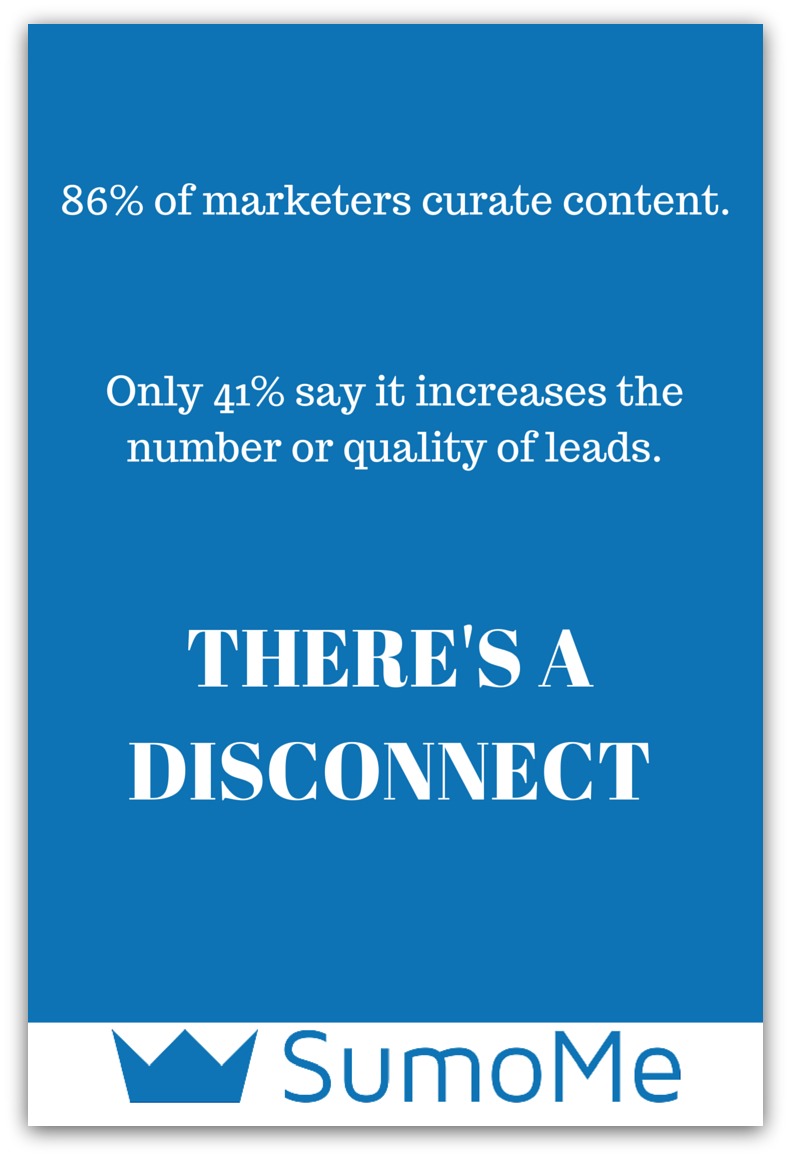
Simple. Because they’re publishing aggregated content.
“But Sean, I don’t do that at ALL. My content is so finely curated I was asked to head up the Smithsonian but I said NAW I love internet marketing.”
I’ll let these two GIFs do the talking for me.


So let’s make an agreement, yeah? We’re going to flood the internet with awesome, must-have curated content. Even if you’ve never curated content before but want to take advantage of all the benefits it offers.
Because I’m going to give you the blueprint for curating badass content that people actually want.
That means I’m not going to list out every tool under the sun, because that’s just crazy confusing (you’ll see why). And I’m not going to speak in hypotheticals that don’t give a clear objective.
What I’m going to do is give you a real process that you can execute TODAY without having to go out and consult other blogs for more information.

Here’s what you’ll get out of this guide:
- The Three Simplified Steps for Curating Badass Content: There’s three steps that all the best content curators follow. I’ll reveal them right here, right now.
- The Right Tools to Easily Curate and Distribute Content: There’s a myriad of tools out there. I’ll show you my favorite ones that are super simple to use (and get big results).
- What to Do AFTER You Curate Content: This is the biggest question curators have. We’ll show you how to leverage your content the right way (with a big surprise at the end).
Time to curate some badass content. Ready?
#strapin
3 Simple Steps for Curating Badass Content (That People Actually Want)
I found something interesting after analyzing the habits of successful curators like Hiten Shah, Maria Popova and countless others.
Every great content curator follows three steps to curate the best content in the land:
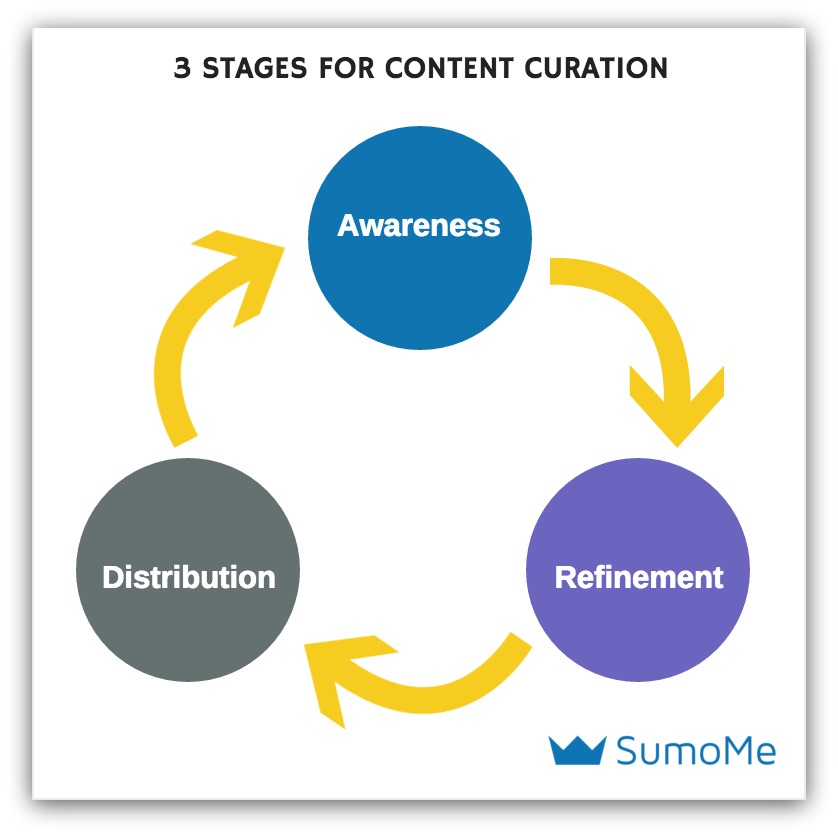
In case you hate beautiful images:
- Awareness
- Distribution
- Refinement
Yep. That’s all there is to successful content curation. Pretty cool, huh?
This should be your basic framework when you’re curating content. Basically, it all boils down to this:
- Awareness: This is where everyone starts off. This is the “crawl before the walk” phase, but it certainly doesn’t have to feel like a crawl. In this step, you figure out your niche and how you’re going to gather information. You’re becoming “aware” to the information.
- Refinement: Once you gather information, you’ll see there’s a lot to wade through. In this step you’ll learn how to quickly identify what posts are good and who writes the best stuff (consistently).
- Distribution: This is where you start to make a name for yourself. You’ll start pushing out your content on various channels, slowly but surely building up a badass email list full of faithful followers.
It’s pretty easy when you boil it down to those three things. So let’s jump right into the first step in this process: awareness.
CONTENT CURATION STEP #1: AWARENESS
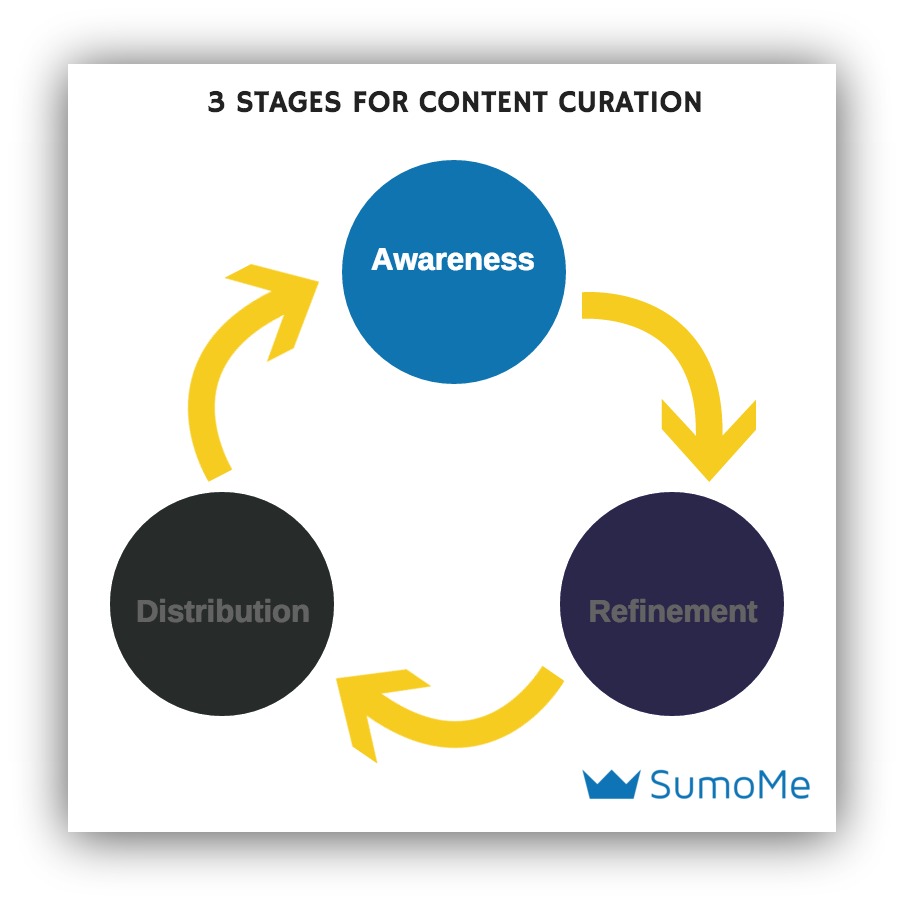
Ah yes. The first steps in a journey of content curation. A wide, vast world of rich content and poor puns await you. Your future audience is out there somewhere, yearning for those sweet content bombs you’re about to drop on them.
So…ah…where do you start?
Well, it starts with identifying what your niche is. Before you even think about content or tools, you’ve got to determine what topic you’ll be known for.
You’ll want to ask yourself three things when selecting a topic:
- What Aligns With My Brand: It makes zero sense for an email marketing company to curate content about cats. Find a topic that relates closely to the services you provide.
- What Are People Seeking Out: Don’t blindly choose a topic and hope people like it. There are ways to see what audiences are searching for. Pick something that’s either low in competition or highly searched (preferably both).
- Would I Like This Topic?: For real…you’re going to be taking in a LOT of content. If you don’t love the topic you choose, you’ll hate curating it. So find something you’re interested in.
Just like I promised, I’m going to show you how I’d do these exact steps. I’d encourage you to follow along step-by-step so you can do some #work while you read this.
So I need a fictitious business. I’ll go with the pet that people actually like (get at me, haters) — dogs.
Looks like I’ve got myself a dog adoption store.

I’ll even give it one of those pun names that make you groan like “New Leash On Life.”
Ok, now you’ve got to determine what your focus topic will be. To do that, get your creative pants on and go for a mind-mapping jog.
Think about all the things your business does and write them down. Then break those out into sub-topics. The deeper you can go into a category, the more content you’ll have to work with later.
You can use a mind-mapping tool like Coggle or Mindmeister for this, but I like to write mine out because I’m an old soul:

I’ve brainstormed some ideas pertaining to my business, like “nutrition,” “dogs,” “training,” and “exercise.”
There are other things too, like “owning a dog store,” and “dog store marketing”. But the common theme of my first-level bubbles had to do with owning a dog. That aligns with my brand, so step one is complete.
Once you pick up a good thread like that, head to the Google Keyword Planner Tool and see how your idea checks out by typing it into the “Search for New Keywords” area:
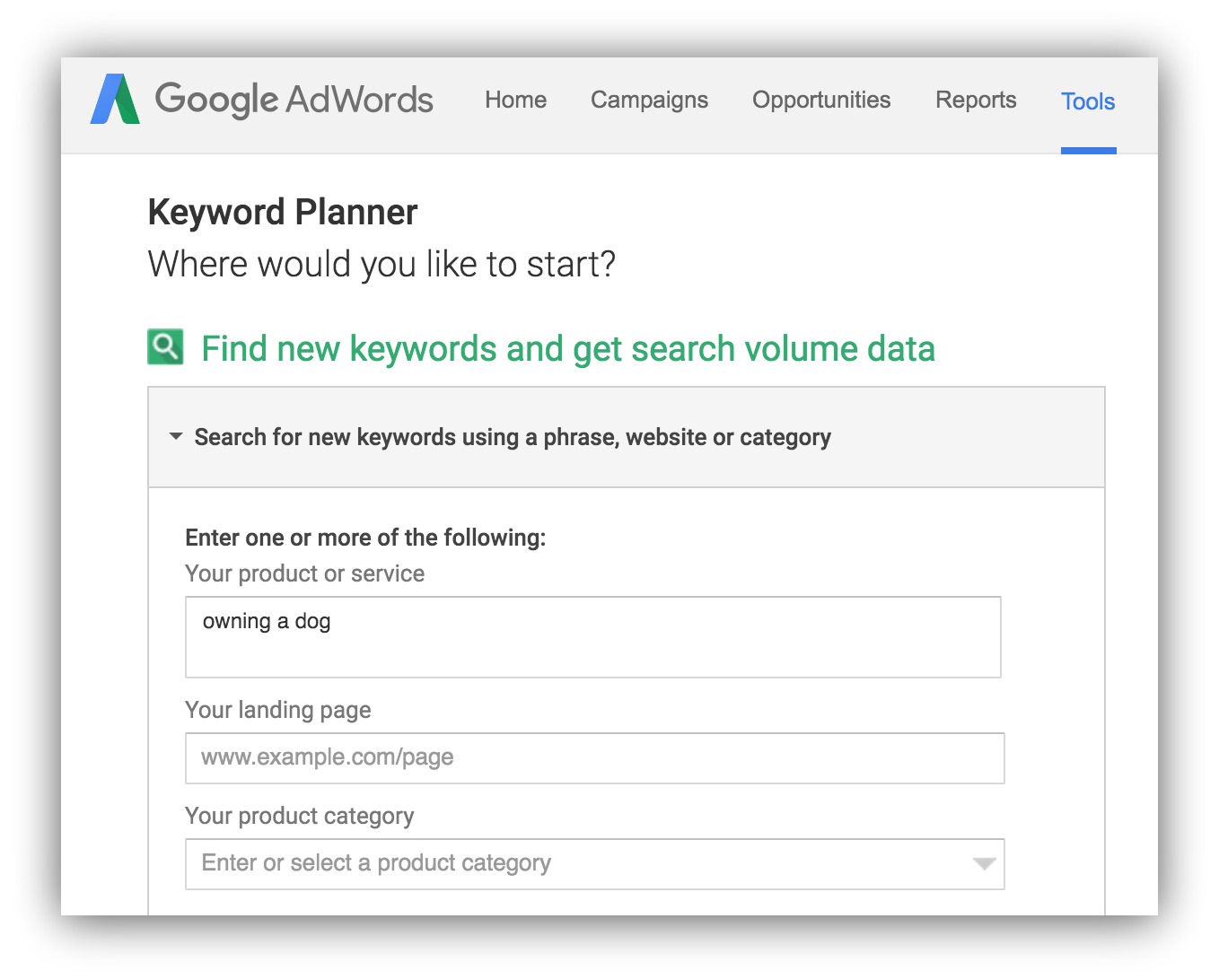
Click the “Get Ideas” section and see what keyword groups come up:
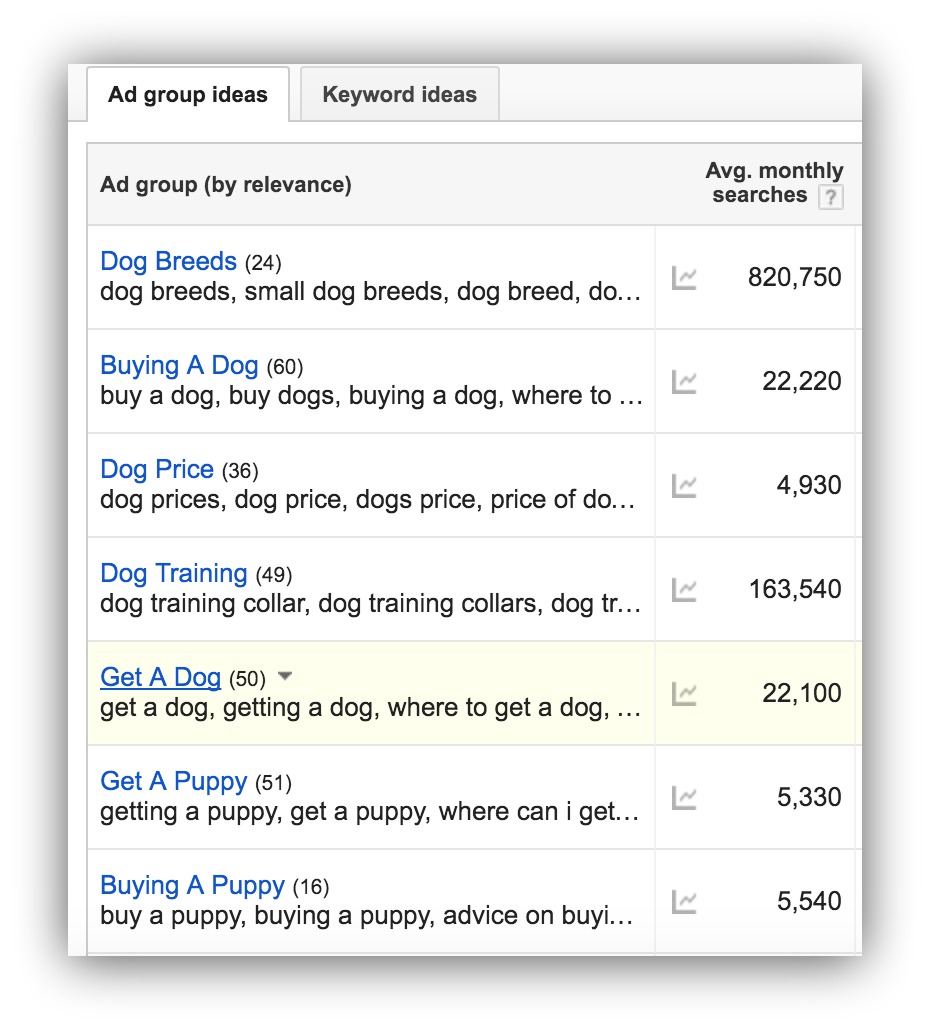
the keywords are grouped together into common themes, or ad groups. Check out which groups have the most monthly searches: dog breeds, dog training and buying/get a dog.
That’s great traffic validation for the overall theme of “owning a dog.” Lots of people are searching for it, so there’s an obvious need. What you’ll want to do is export the ad groups into a spreadsheet so you can reference the keywords and traffic in a later step:

That leaves me with the last question to answer: would I like this topic?
Answer: hell yes I love reading about/watching dogs.
Do you love what you’re about to curate content about? You might have an answer now, but you’ll have a definitive feeling after a few weeks of curation.
All the questions to ask yourself are covered at this point. You should have a topic that aligns with your brand, is something people search for and something you love.
Sweet. Let’s dig into the nitty-gritty part everyone is dying to see — the content curation tools.
Five Content Curation Tools

This is where it gets tricky. Take a look at this list of content curation tools from Robin Good and try not to let your eyes glaze over.
Seriously. Take a look at that list. I’ll wait.
Point is, there are way too many tools out there for this job. One of the biggest mistakes people make is subscribing to too many tools and getting quickly burnt out.
So I’m going to give you the only five tools and sites you need to start aggregating all your content right now.
Tool #1: Feedly
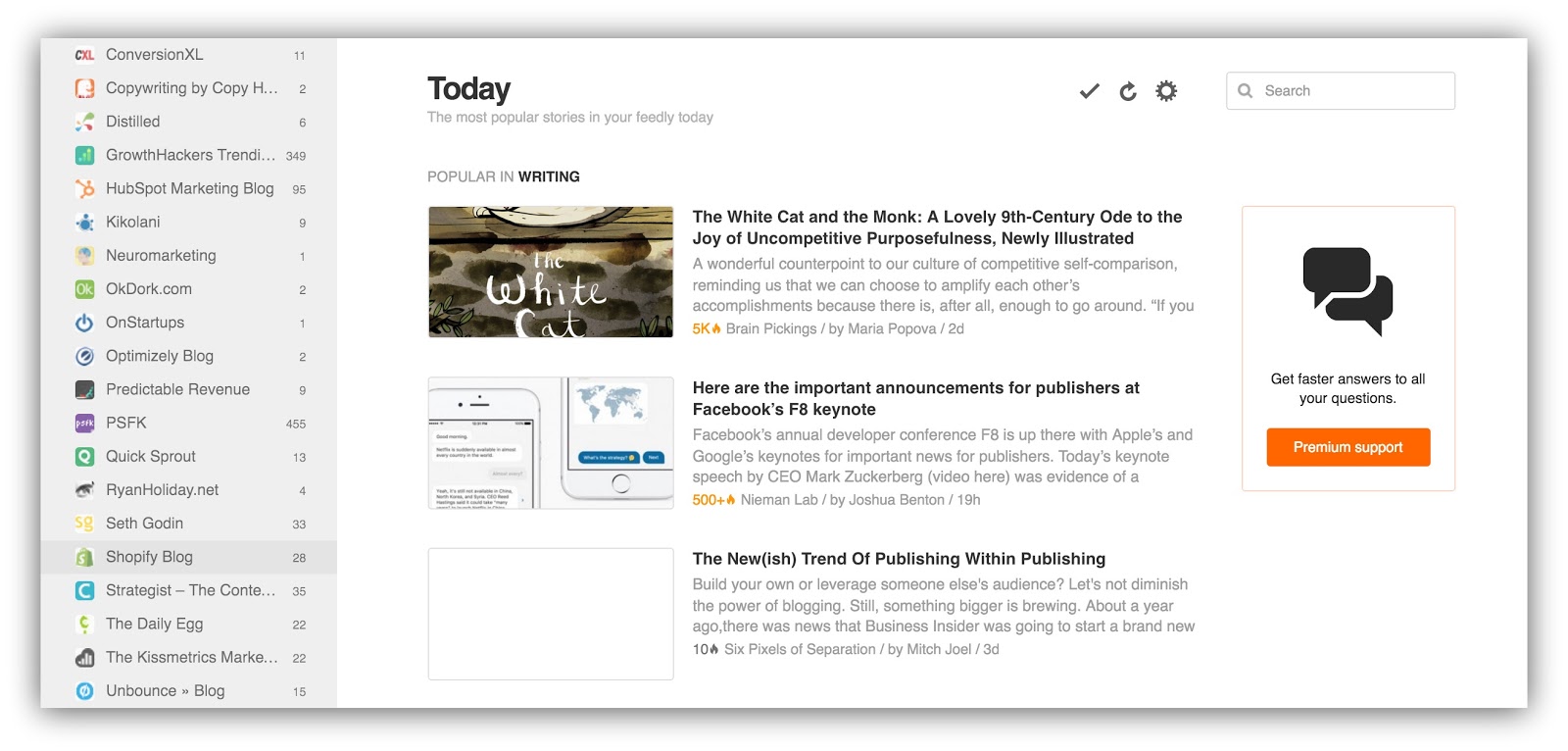
Hey, that’s MY feedly! Just…ignore all the unread articles…
It’s no secret that the majority of content you’ll curate will be articles. You’ll need an easy way to pull all that content together in one place.
I use Feedly because it’s a super clean and easy-to-use blog aggregator. It only aggregates blog posts, though, which some people seem to think is a negative.
I love that. When tools start to try and do too much, they become less and less easy to use. With Feedly, everything is intuitive enough to breeze through articles.
Tracy Mallete, founder of Content Newsroom, agrees:
“My top tip is to get set up with a blog aggregator like Feedly and populate it with the blogs you want to pull from. This saves a ton of time, because all of the content you want to curate can be found in this one location — and you can categorize the blogs by content type, topic, company, etc.”
Well said. Alright, it’s time to fill this bad boy up with some blog topics. When you sign into Feedly for the first time, you’ll see a screen like this:
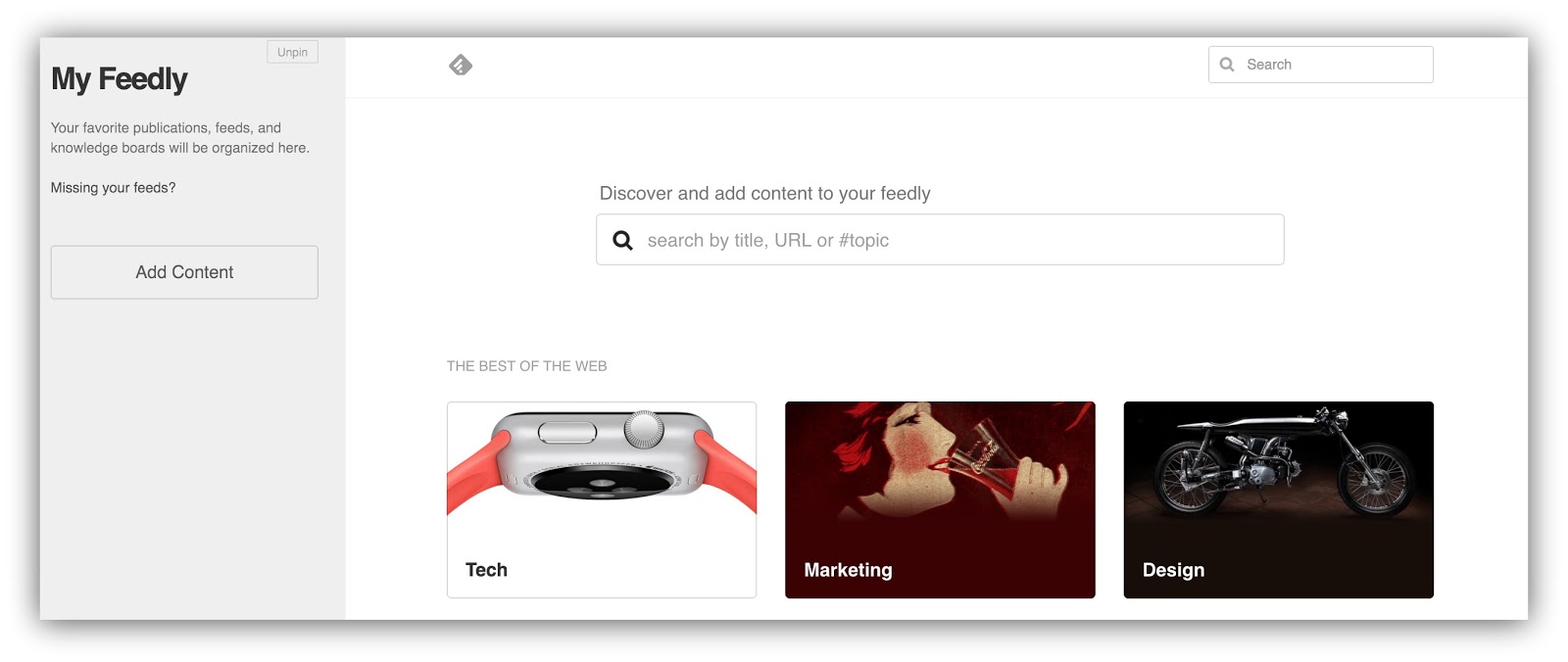
Since I’m building out a feed on dog ownership, I’ll start with searching Feedly for anything including “dogs” (I’ll sort out the results as I go with such a broad keyword):
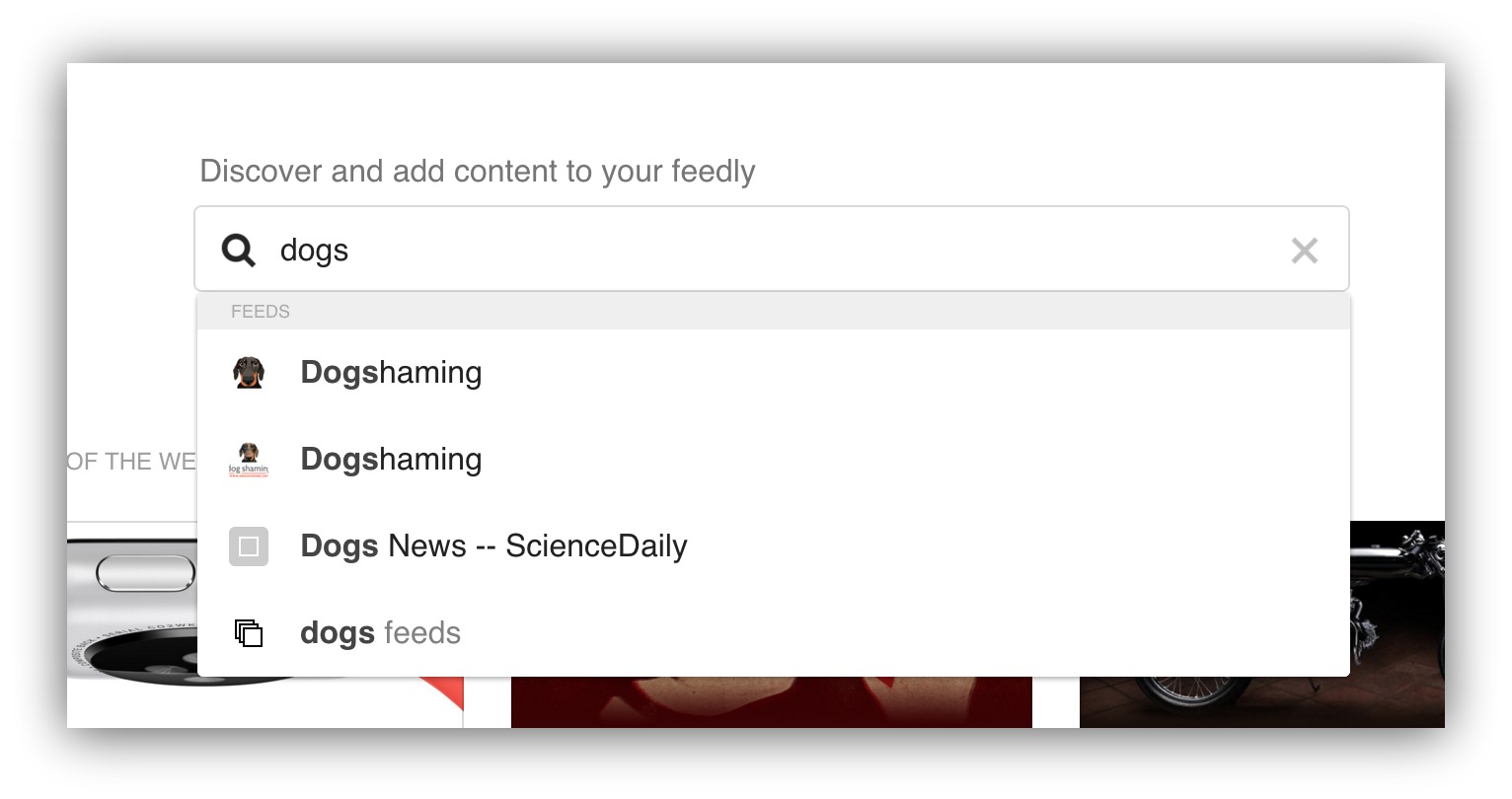
Interestingly enough, “dogshaming” is the first thing that pops up. It’s not really what I’m going for, but I can tell that it’s a hot topic. I’ll put it in my back pocket to explore later, instead clicking on “dogs feeds” to see other dog-related feeds:
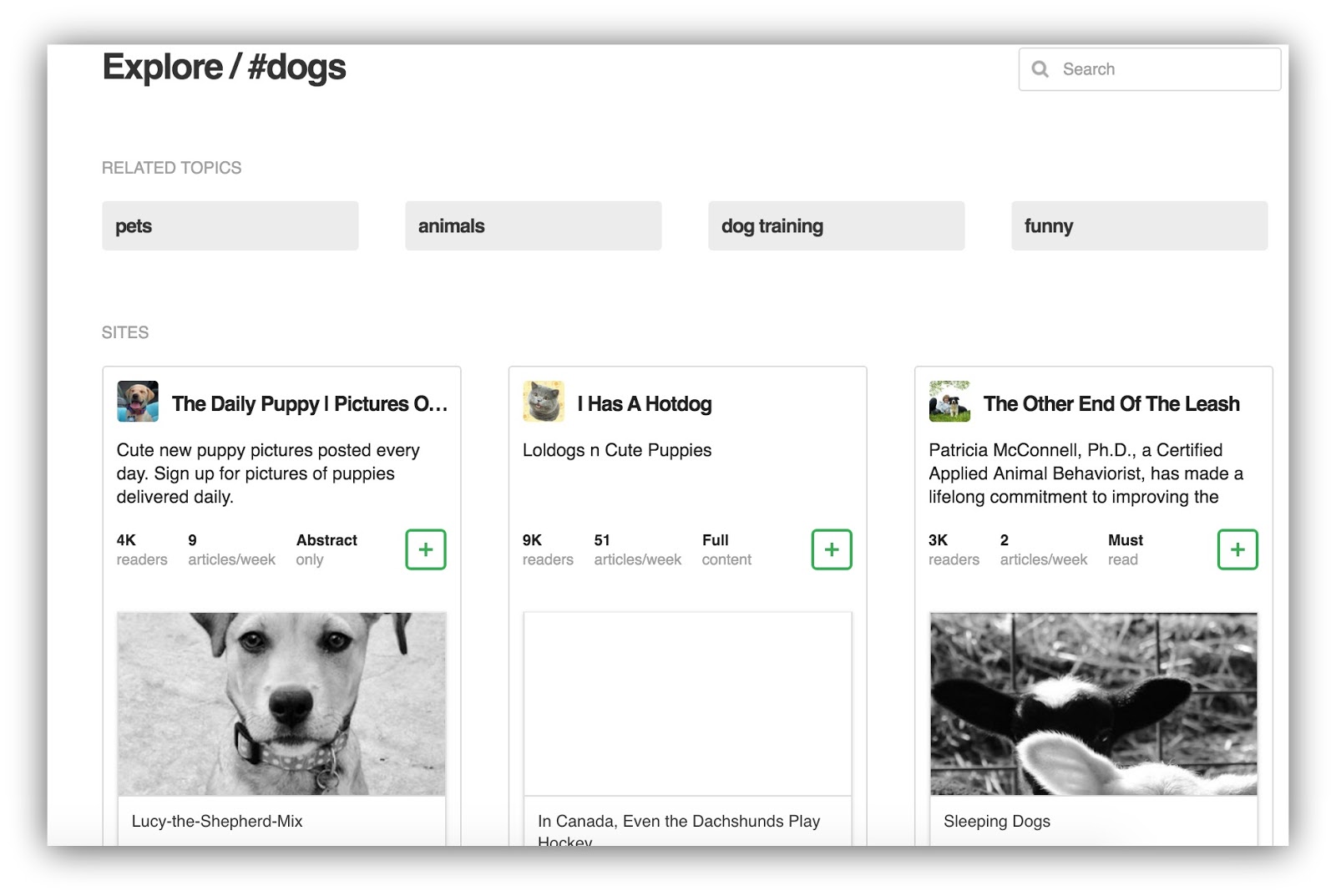
You can scroll through and see what each feed is all about, and you can add the feeds that pertain to your topic by clicking the green square with the plus icon in it.
The best advice here is this: add as many of these feeds as you can. There’ll be time to filter out the sub-par feeds later, but for now you’ll want to have a wide breadth of options to curate from.
Repeat this whole process for every big keyword you chose from the Google Keyword Planner Tool. For me, I’ll be searching for “dog training,” “buying a dog” and “dog breeds.”
Once you go through and add these suggested blogs, your sidebar will start to look like this:
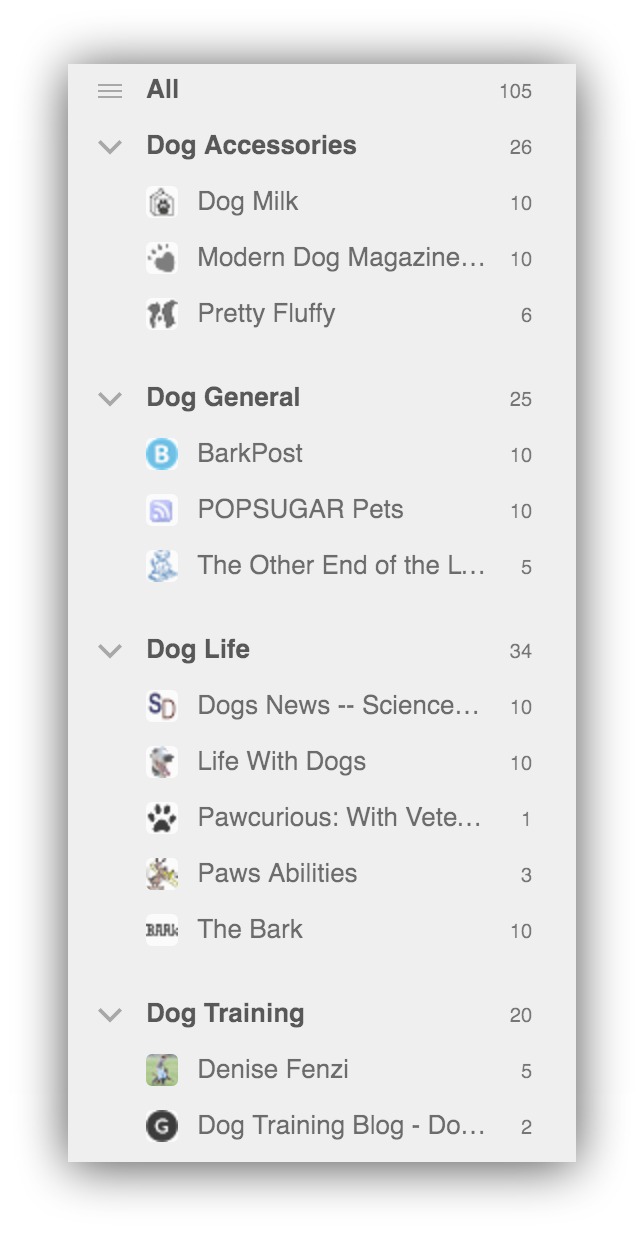
That’s great! But guess what? There’s one more step you’ve got to take to truly build an above-average feed.
And it comes to us courtesy of existing content curators. Curators helping curators. Who knew?
Head over to the Google machine (or Bing, if you’re so inclined), take the same keywords you searched in Feedly and plug those into the search bar with this phrase:
“Best (your keyword) blogs”
When you do that, you’ll see posts published by content curators with the goal to point readers to the best blogs in a particular field or genre.
And we’re going to use the hell out of that. For my example of dogs, check out this post:
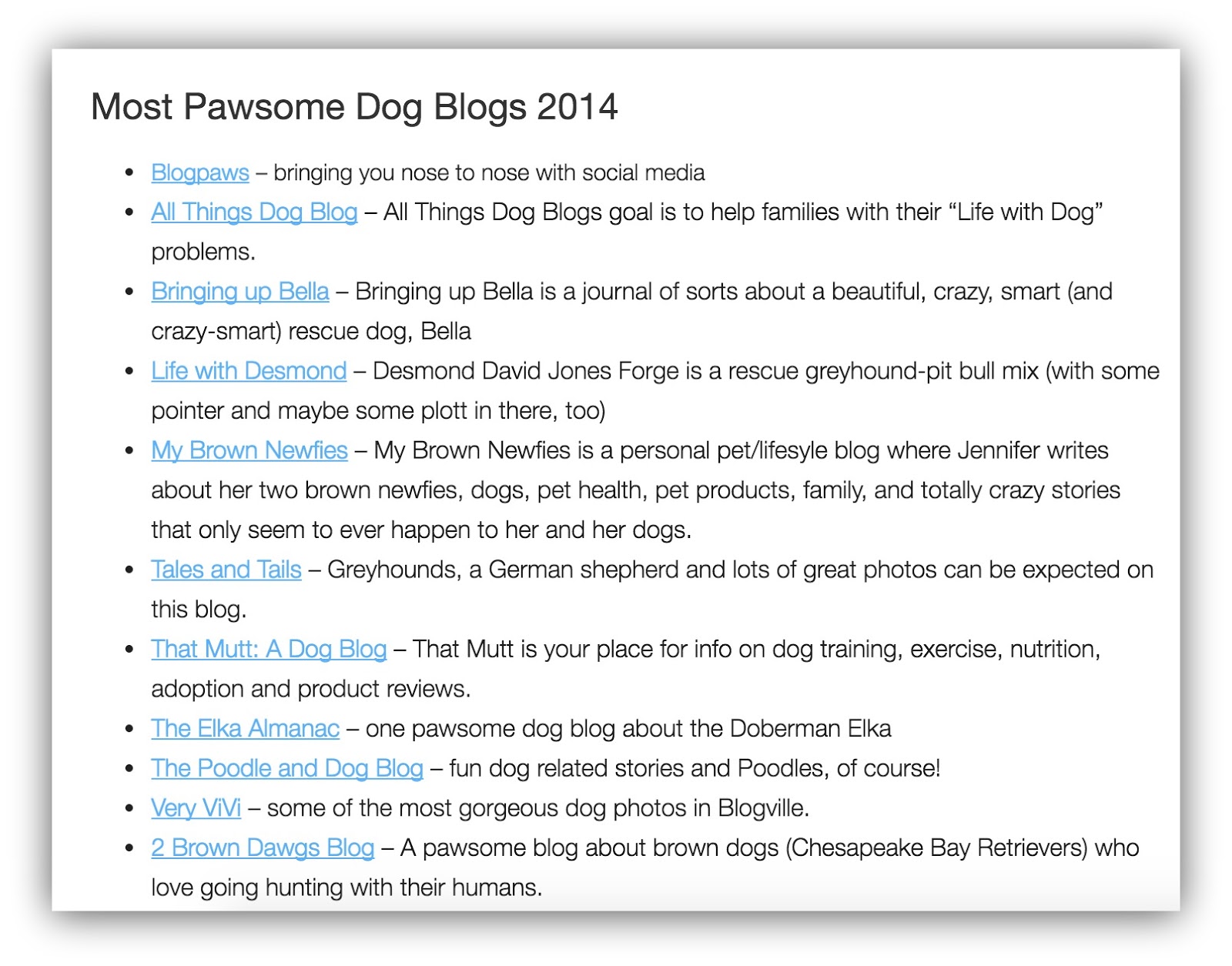
From alfiesblog.com
Doesn’t matter if it’s from 2014. You better believe I’m going to follow these blogs in my Feedly. Again, you can worry about sifting through them later. Right now you just need sources.
To add these to your Feedly, just head click the “Add Content” button and copy/paste the blog URL into the search bar:

Then you just click on the feed and add it to one of your lists. Do that until you’ve literally scoured the internet for every awesome blog that pertains to your keywords.
Done? Excellent. Now you should have a (Donald Trump voice) YYuuuuuge collection of blog posts to look at every day:
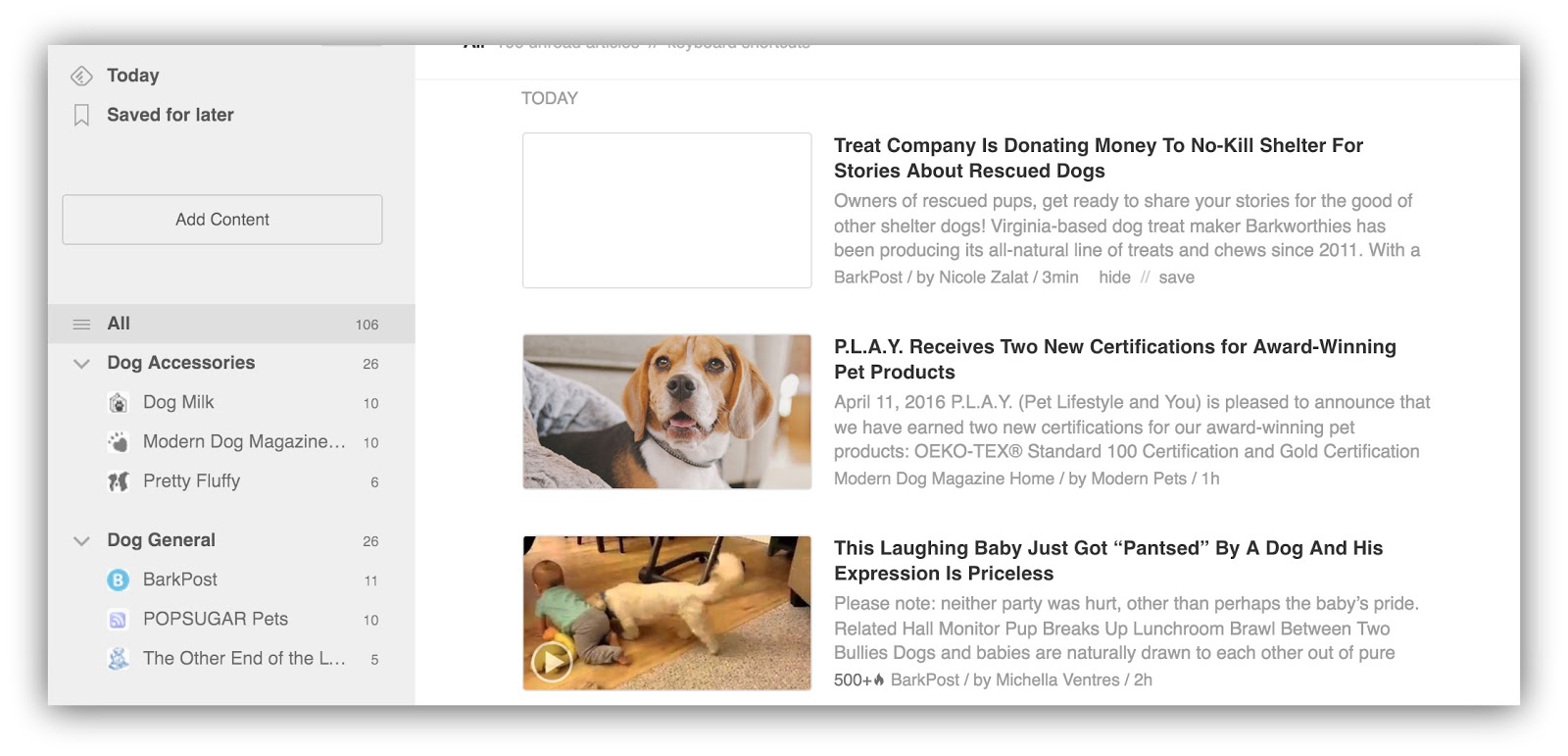
So there’s your main source for finding awesome blog posts. I’ll share with you real quick two other tools you should use to find great content (but not spend as much time on).
Tool #2: Reddit
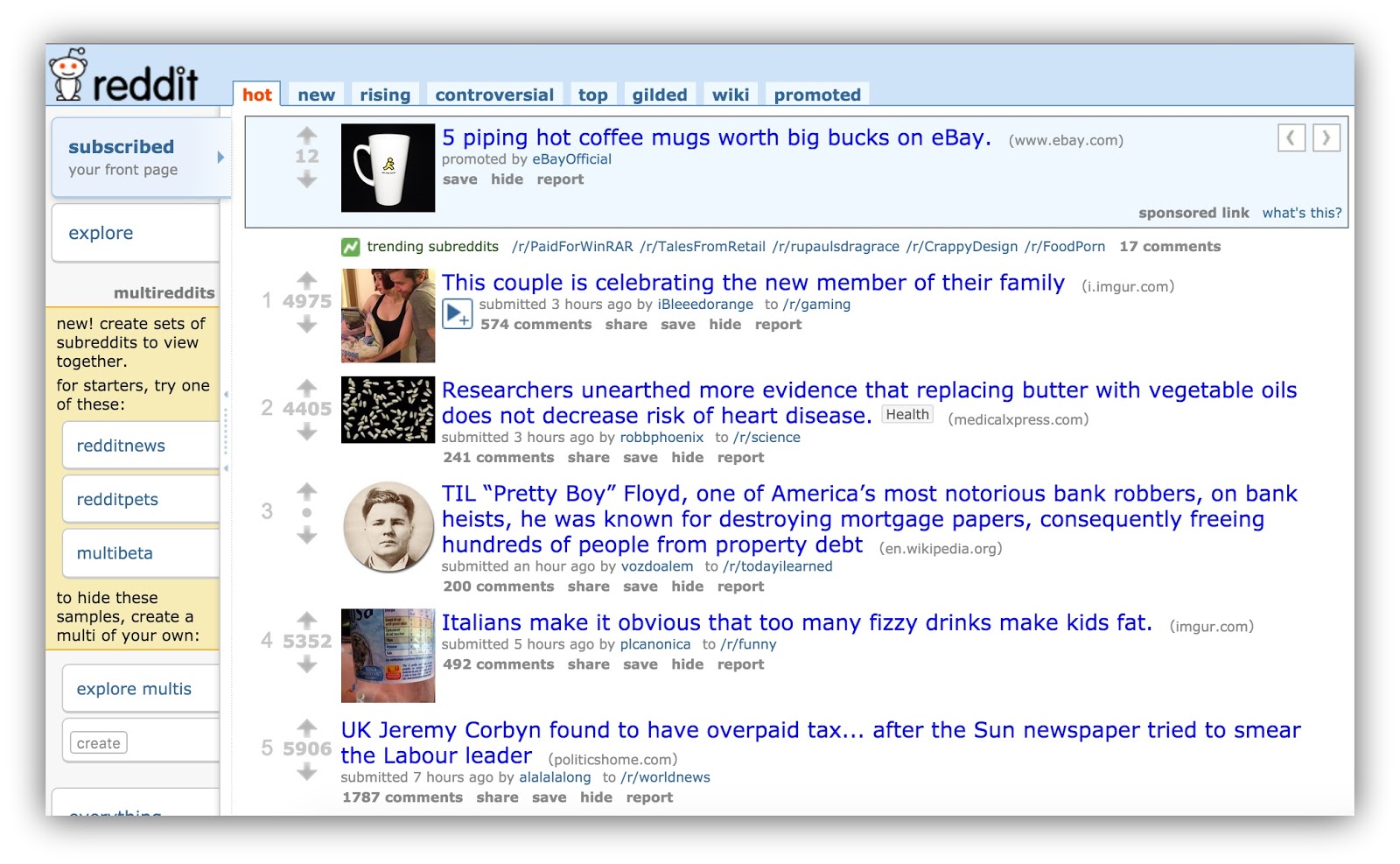
You comin’ after my fizzy drinks, Italy?
Do you know how many monthly pageviews Reddit gets?
8.54 BILLION.
Needless to say, it’s a popular news aggregation site. Plus, you get all sorts of content like blog posts, videos, infographics and a whole lot more.
The reason you’ll be using it (or at least checking it) is twofold:
- News Breaks on Reddit: Oftentimes news is broken on Reddit, or something happens on Reddit that becomes a story news outlets report on. These stories matter, so you’ll want to catch and include them in your curation.
- See What’s Popular: Reddit works on a system of user-based upvotes. If something’s good, it’s upvoted. If not, the downvotes come out. By monitoring stories by upvotes, you get some social proof behind what stories you curate.
You can get some great pieces of content from Reddit, but you need to know where to look. So all we’re going to do for Reddit is this…
Take your main keywords from the Keyword Planner Tool and search for those on Reddit. For each keyword, you’ll see subreddits (read: topics) you can subscribe to. There are around 856,000 subreddits at the time of this writing, so chances are you’ll find a few good ones.
Subscribe to the ones that are A) relevant and B) have high subscriber numbers (means more postings):
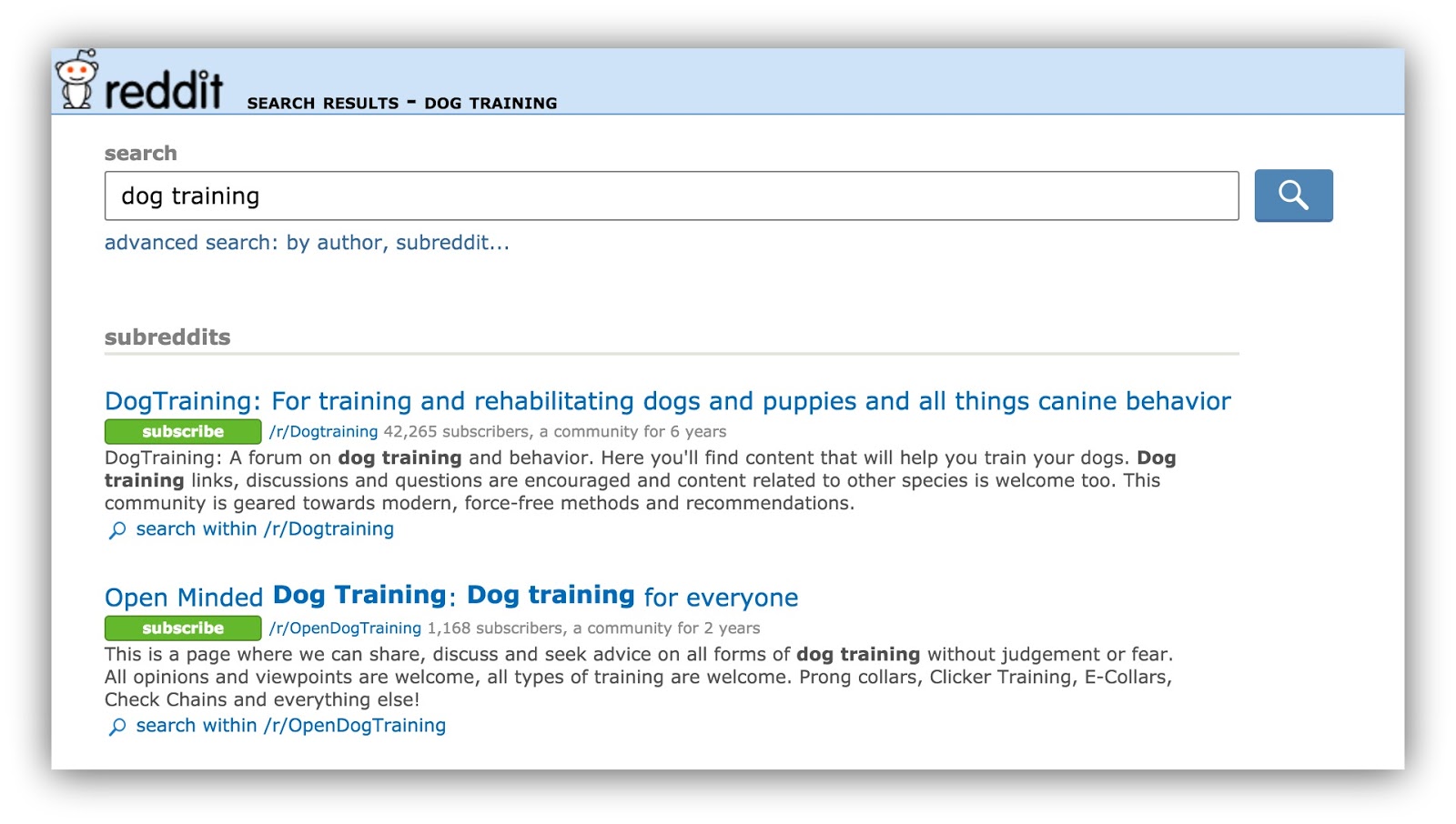
I subscribed to these two for dog training, for example.
Once you subscribe to these subreddits, you can go to your homepage and see all the posts from your new subreddits. The added benefit with Reddit is you can sort this content three ways:

- Hot: Content that’s been quickly upvoted and is considered a major/popular piece of content.
- New: Recently submitted content that may or may not get upvotes.
- Rising: Content that’s newer and is getting some traction, on it’s way to “Hot.”
Each tab serves a purpose. If you’re looking for tried-and-true content that’s guaranteed to hit, go for “Hot.” It’s less work to filter out because you know it’s already good stuff.
If you’re looking for content that’s off the radar, you can try the “New” tab. You’ll have to read a bit more to determine if the content is legit, but you’d be able to grab content that your competitors most likely don’t have.
“Rising” is the content that’s right in the middle — starting to generate buzz, but not widespread yet. This is generally safer content to plug-and-play, but you’ll still have to dig in and vet the content.
Pro Tip: Don’t spend a ton of time on Reddit. No, I’m not your parents scolding you. It’s just easier to think of this as a supplement to Feedly, so allocate your time accordingly.
Here’s one last tool for vetting content that’s popular…
Tool #3: BuzzSumo
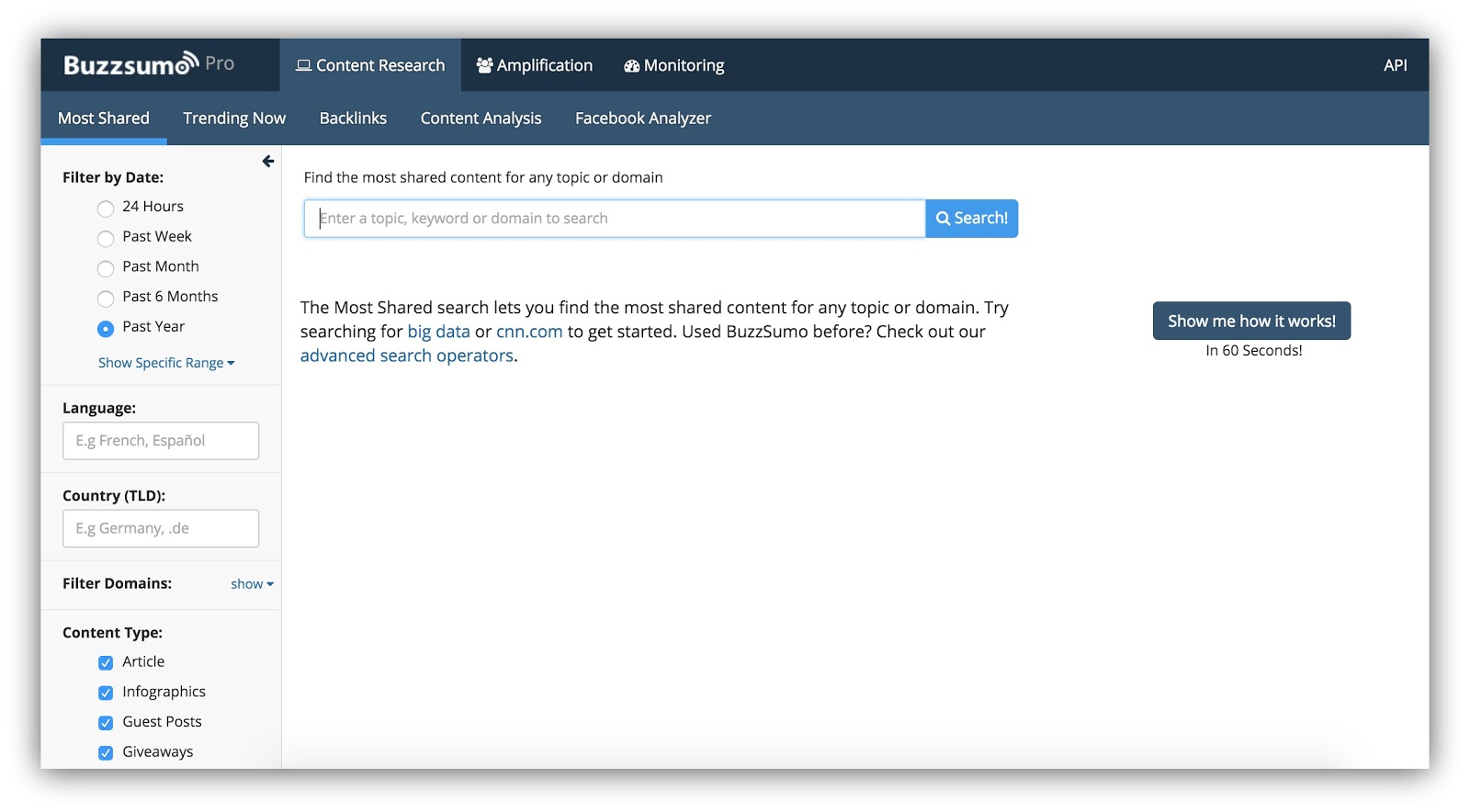
BuzzSumo is a tool that finds the most-shared content in a given time frame around a certain keyword. Of the three tools mentioned so far (Feedly, Reddit and BuzzSumo), you’ll use this the least.
Why? Because Reddit contains highly shared content, and your Feedly should be pretty robust. Nevertheless, this is a great tool for finding great content that slipped through the cracks of Reddit and Feedly.
Grab that handy-dandy keyword list again, ‘cause you’ll be using it to search for some articles here. You’ll want to filter by “Last 24 Hours” to get the freshest stuff, then enter your keyword to get this:
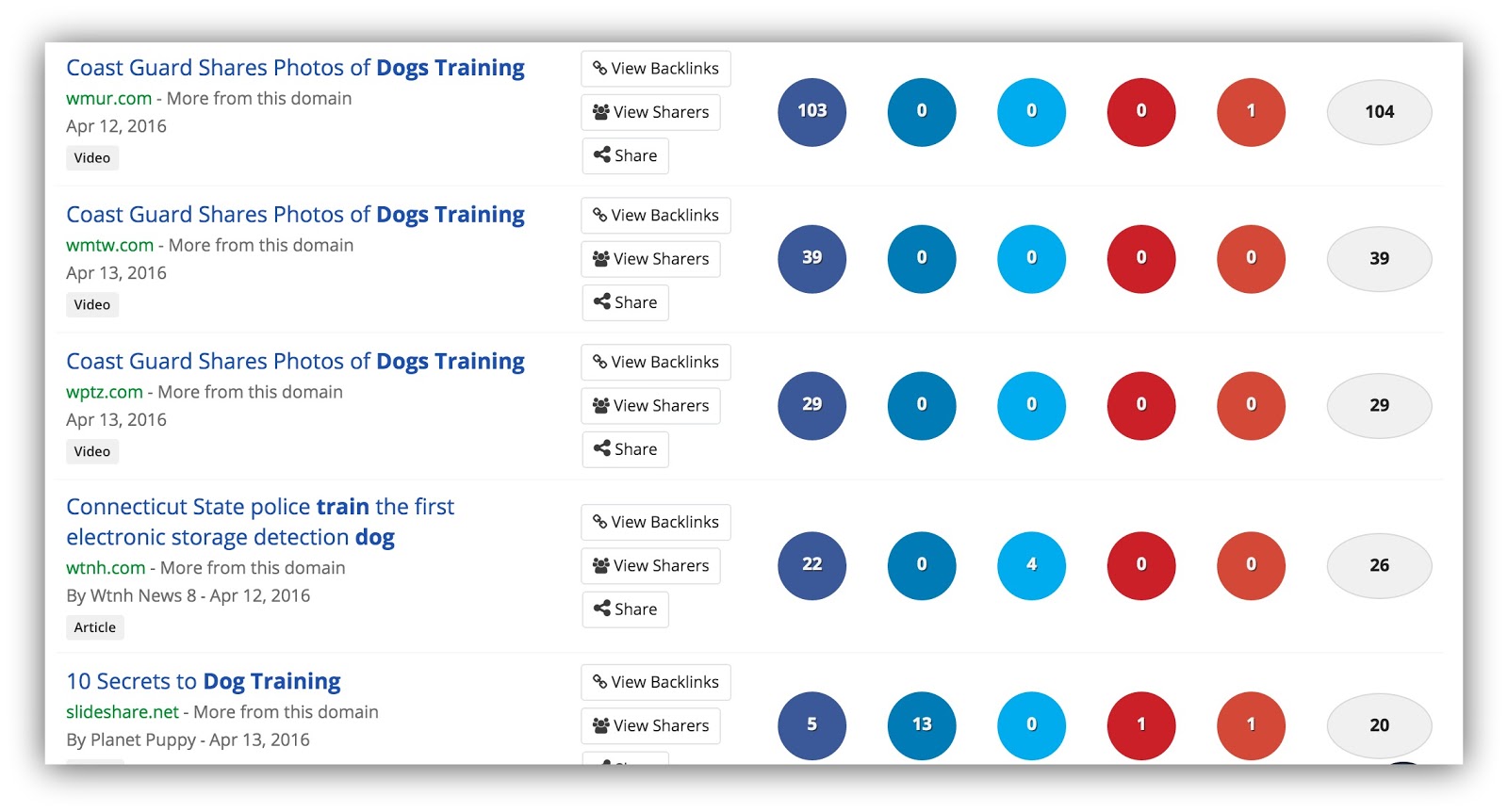
Circles represent social media shares. In order: Facebook, Linkedin, Twitter, Pinterest, Google+
Alright, so it looks like this coast guard story is popular. I’d check that out, along with the following two articles about dog training.
Whatever your topic is, BuzzSumo arranges the content in order of most to least shared. All you have to do is scroll through to see what content matches up with your message.
Like Reddit, you’ll spend just a little time on BuzzSumo to get some extra pieces of content. But between Feedly, Reddit and BuzzSumo, you’ll be more than covered with blog-type content.
So let’s dive into two other ways to curate non-article content.
Tool #4: YouTube
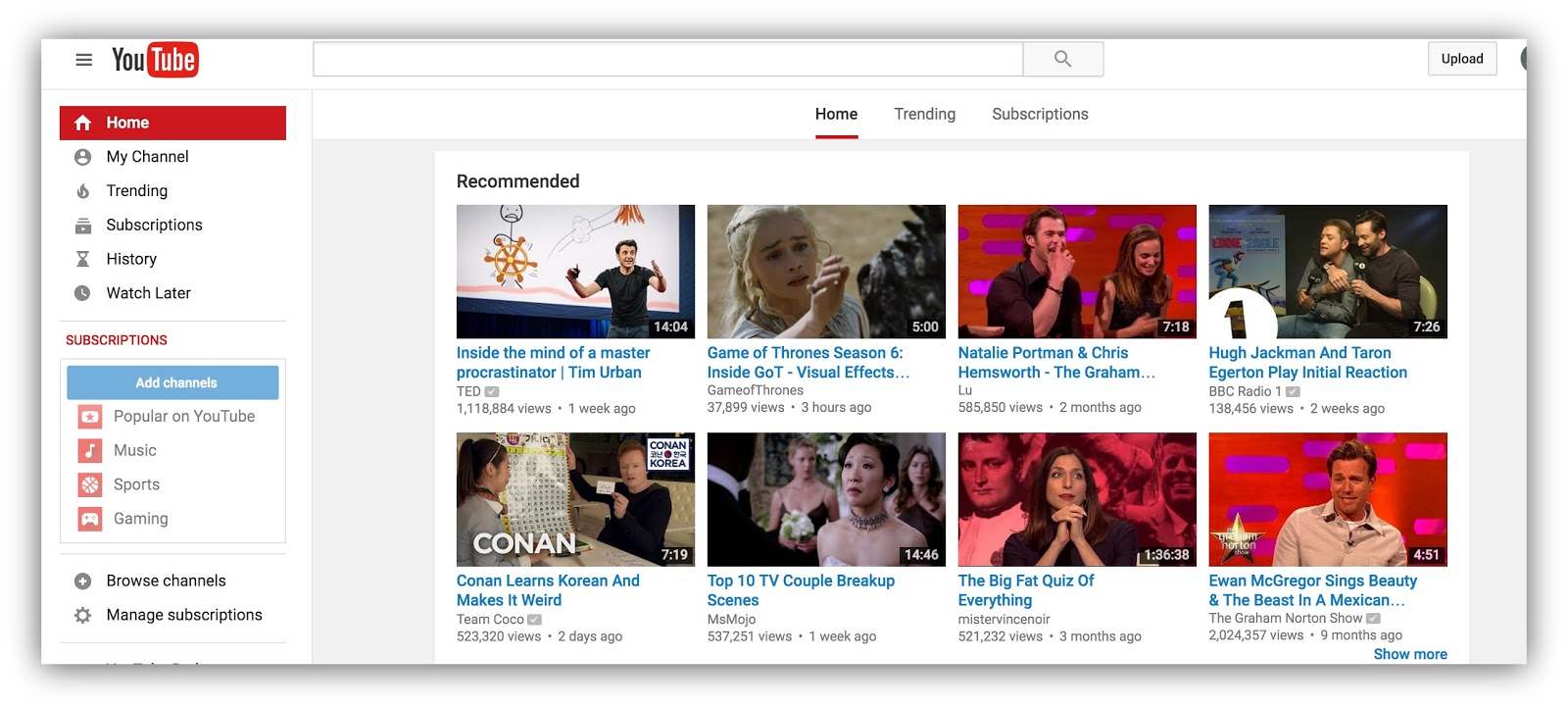
As you can see, Graham Norton Show clips are an obvious weakness of mine.
You know what YouTube is. I won’t spend a lot of time explaining the inner workings.
What I will explain is how to curate excellent videos. Let’s play that broken record that sings our favorite tune: “Get out those keywords from the Keyword Planner Tool.”
(Hint: You might have guessed by now, but that keyword generation step is really important.)
Click the link that says “Browse Channels” in the bottom left-hand corner and enter one of your keywords in the search bar:
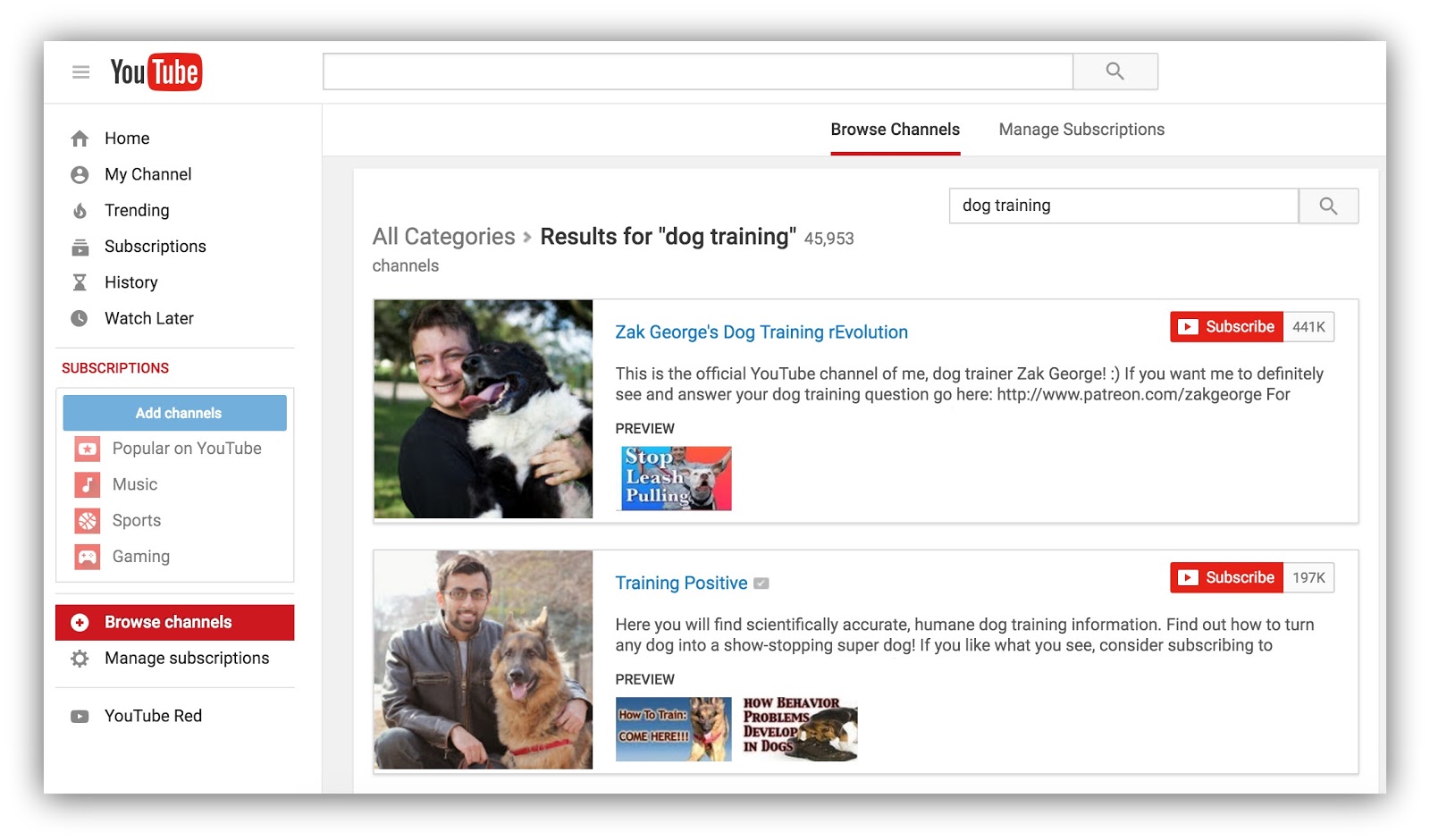
Early on, subscribe to the channels that have the most followers – that’s battle-tested content right there. Later you can start to seek out the deep cuts – gems hidden under low subscribe numbers.
Once you subscribe to a few channels, you can go to the “Subscriptions” link and see all the posts for each day:

You’re getting some serious free promo right now, Peter Caine Dog Training…
From there you take the time to watch the videos and determine if they’re a good fit for your audience.
You’ll most likely have a theme or category to satisfy when you move on to content distribution (more on that later), so you can narrow down videos by keeping that criteria in mind.
Alright. We’re down to the last tool, and it’s a bit…different…from the others.
BUT, if you want to add significant value to your curation (and your knowledge-base), consider this last site a great resource.
Tool #5: Goodreads

My friend Victoria Englund reads a lot.
Think of Goodreads as “Reddit for books.” People can rate books, add them to lists and give recommendations for similar titles.
The interesting part you should focus on are the lists. This is where you’ll live on Goodreads.
In the dropdown menu, select “Browse Lists” and then do that thing we do a lot a.k.a. Search by your keywords and you’ll see lists that pertain to that keyword:
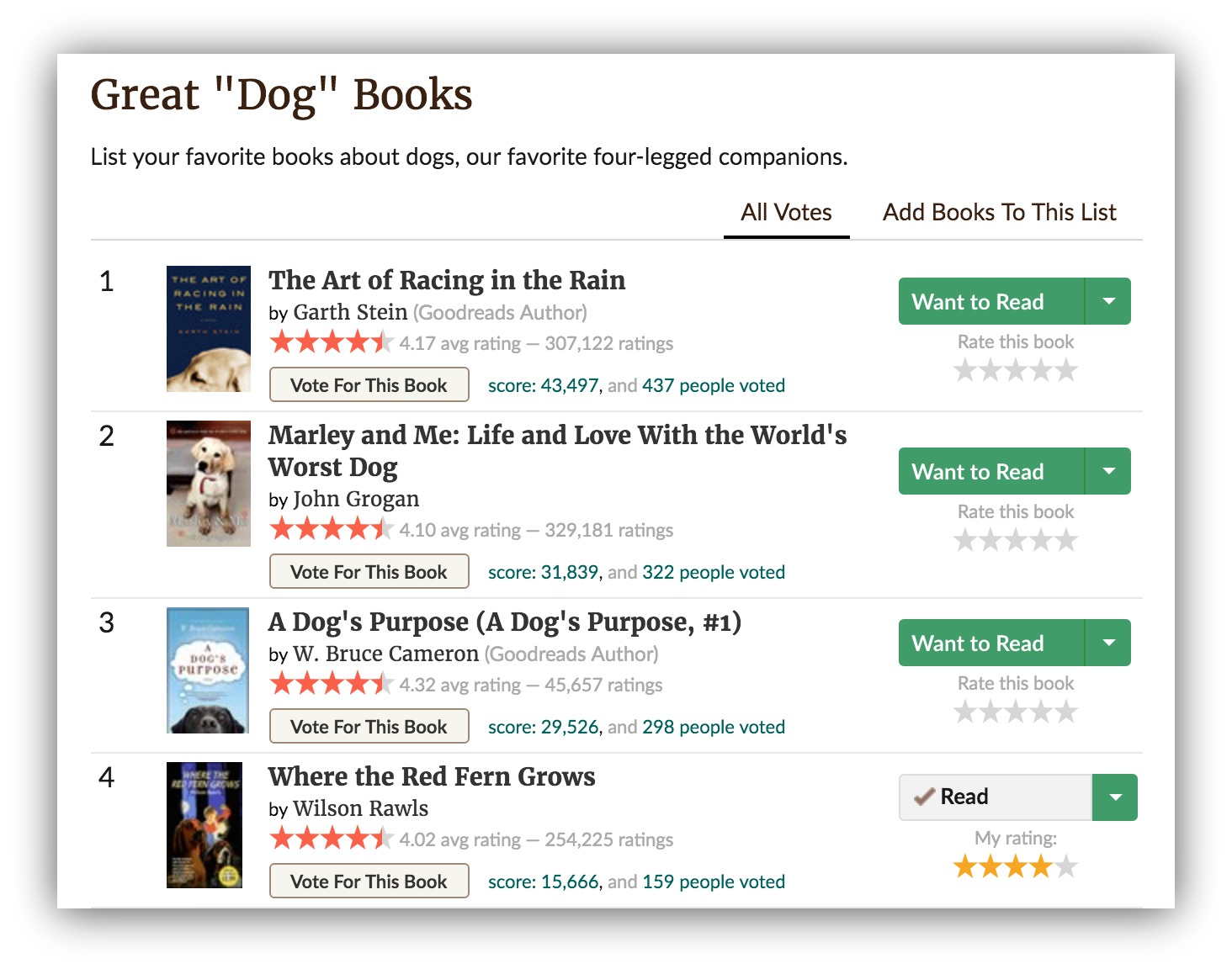
What kind of monster gives Where the Red Fern Grows four st….oh….that’s me
In these lists, you’ll see a ranking of books. These rankings are created by users voting on the quality of the book a la Reddit.
This is where the time commitment comes in. Book recommendations in curated content are popular because they provide a longer, more in-depth reading experience for the viewer.
If you’re up to it, you can work your way down these lists and read them (or listen on Audible). A book recommendation always stands out amongst blogs posts and videos, and you can base an entire section of your site on reviews alone.
But for the love of all that’s Gary Busey, do not read a review on a book and pretend you’ve actually read the book. It’ll come across as fake and your readers will smell it a mile away.
So those are the five tools and sites you need to start aggregating all your content right now. These five tools cover almost every form of content possible — articles, videos, books, infographics, etc.
It may seem like a lot to do initially. But consider the daily life of the previously mentioned Maria Popova — creator and curator of Brain Pickings — in how she described her routine in an interview with The Great Disconnect:
“I get up in the morning and preschedule some of my tweets and do very mild email. Then I head to the gym where I do my long-form reading on the iPad while on the elliptical. I come back, have breakfast, and start writing. I write three articles a day—usually two shorter ones and one longer—so I try to write the longer one in the first half of the day before things get too crazy.
In the afternoon, I do more reading and preschedule the second half of my tweets. In the evening, I do yoga or meditation and then I usually have some sort of event or a one-on-one with a friend, which is my preferred mode of connecting.
When I get home, sometime between 10pm and 1am, I write the remainder of what I haven’t finished.”
She literally reads hundreds of pieces of content per day. Granted, she’s quite possibly the best curator of our generation, but the message still stays true:
You’re going to have to work to make something great.
And to make something great, we move to the second phase of great content curation:
Refinement.
CONTENT CURATION STEP #2: REFINEMENT
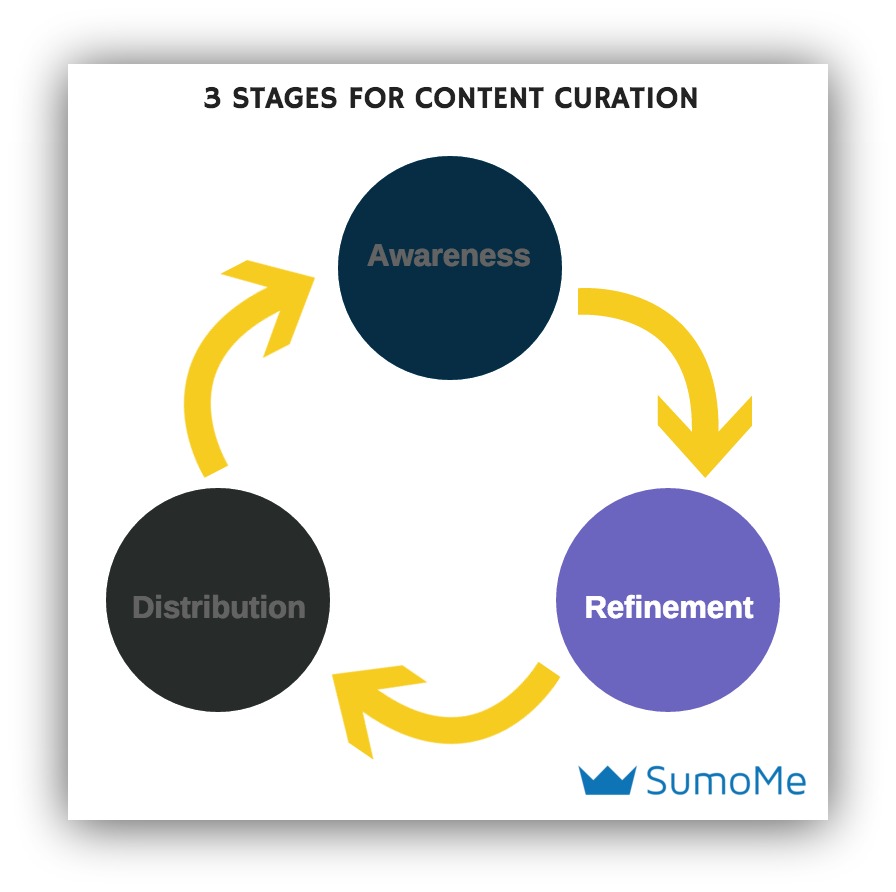
You know how on MTV Cribs they go to the bedroom and say “Yeah, this is where the magic happens *awkward laugh*?”
Well, the refinement step is where the magic happens in content curation.

Literal magic
This is when you transition from being a content aggregator into a full-fledged content curator.
So what’s that mean? It comes down to you being a content gatekeeper.
If you expect people to read, interact and subscribe to your stuff, you’ve got to provide them with the best content available. It should be content that adds significant value to their lives.
It’s tough to get there. But I’ll give you five steps to help get you there faster than everyone else that tried content curation.
1) Take in Everything
Those five tools and sites we talked about just now? Review them #everydamnday.
If Malcolm Gladwell said it takes 10,000 hours to master something, then you can surely spend an hour a day combing through all the content you’re aggregating.
Heck, for the dog example I use in this article I watched 14 videos, read 11 infographics, listened to a podcast AND read all 121 articles in my Feedly.

I know more about dog stuff than I even thought possible.
By taking the time to look through all that content, you’ll start to see what makes great content. For example, I took these notes when I read highly shared articles about dog training:

Once I started picking up these trends, I could almost tell from a headline how the content would shape up. That helps shave off lots of time when you’re taking in so much information.
After you pick up on these trends and get a better feel for what makes great content, you move on to filtering out the weaker sources.
2) Filter Out Weak Sources
Remember how I said to just worry about adding as many blogs and producers to Feedly and YouTube as you could?
Now you’re going to want to start taking the axe to a few of these sources.
The reality is some of these sources plain ol’ won’t deliver great content. You’ll be able to tell because one (or more) of three things will happen:
- They never post: You might have added a dud in your content aggregation flurry. I know I did — 11 blogs, to be exact. It happens, but when they don’t post anything for long periods of time, it’s time to cut them loose.
- Their content is never shared: This isn’t a hard rule, but generally speaking if more than a few pieces of content from one author aren’t shared, it’s time to move on. The viewers don’t feel justified sharing, so why should you?
- Their content just isn’t good: You’ll be able to tell after a few posts if an author is producing quality content. If you find yourself going through their stuff and muttering a simple “meh” then you should cut them from your list.
After this process, you should be left with a lean, kick-ass list of content creators. But the real test comes after this simple game you should play.
3) Play the Guessing Game
It’s weird, I know. But let me explain.
After I looked at piece of content after piece of content, something weird started to happen.
I could guess how popular a post was based on the headline.
It was scary. I was pretty accurate most of the time, too. What I’d do is go into Feedly and turn my homepage into a grid, email-like display. Then I’d cover up the amount of views on an article and guess how popular that article was.
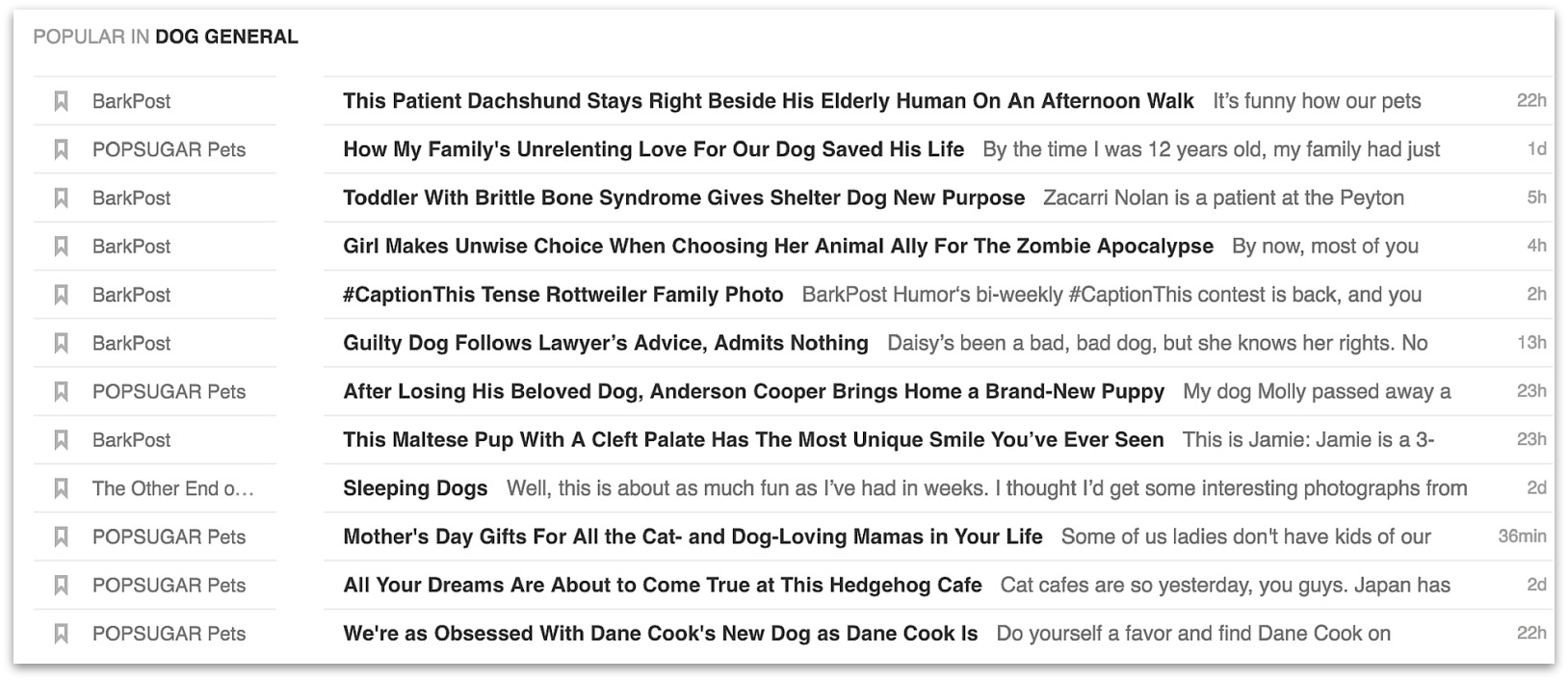
What do you think the three most popular articles were? Don’t worry, I don’t expect you to be a dog expert. Just look at the headlines and guess.
Ready? Check it out:
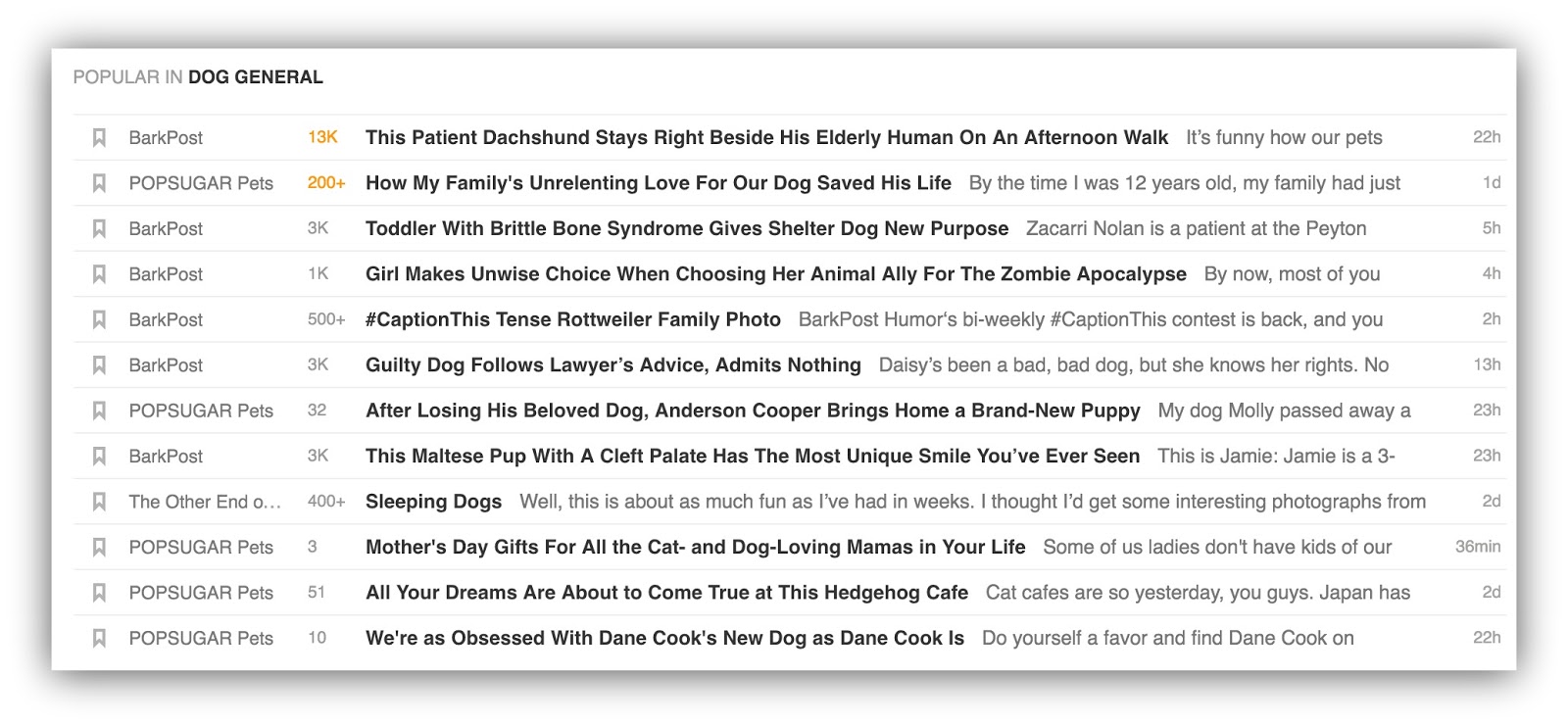
There they are. When you get in tune with your subject matter, you’ll start to develop a sixth sense for article performance.
Now, this isn’t a “once you snatch the pebble from my hand you shall be ready” kind of thing. It’s more like a test to see how well you can predict popularity. It’s something that will help you curate only the best content.

Grasshopper, you must surely know how many times this will be shared on Google+
If you think you’ve got a pretty refined sense of what good content is, then congrats! You’re ready to move on to the actual curation of your content.
4) Start Saving Great Content
It’s time to actually curate all that content you’ve been aggregating.
All you need is a place to store it. A lot of curators swear by Evernote, Google Docs and Notability, but all you need is a trusted place that you can easily access when you’re curating content.
I use a mix of Evernote and Google Docs. Whenever you’re picking out the content you want to share with people, you need to include at least three things: title, link and description.

My own notes.
The title and link are obvious, but the description is what you should focus on. Give your in-the-moment thoughts as to why you like that content — it’ll help you remember why you want to share it.
Grab those notes and head over to the last (and most important) step of the refinement process.
5) Test it With Small Target Audience
C’mon. This is Sumo! We wouldn’t have you try something without testing it out first. You’ll want to test out your curation skills on a small group before you really invest resources into it.
The best way to do this is to reach out to people you know for validation. It can be friends, family, colleagues, whomever! The only rule is they have to be in your actual target audience.
My friend Will has a five-year-old dog, so he was purrfect for this experiment:

Everything I did was straightforward. I said what I was doing, how it would be beneficial to him and gave a sample of the content I curated, asking if he’d want more or not.
This approach is great because you’ll get some honest feedback. Either it’s good-to-go and you can move on, or they’ll give your real feedback to help out. It’s a win-win.
If you need to go back to the drawing board, that’s ok. The definition of refinement is literally “the improvement or clarification of something by the making of small changes.”
You may have to make small changes in the sources you gather or the topic you chose. Or maybe you need to keep taking in content to truly become a great curator.
But once your curation skills are up to snuff, it’s time for the last step in the content curation cycle — the one that will grow your brand and list.
Distribution.
CONTENT CURATION STEP #3: DISTRIBUTION
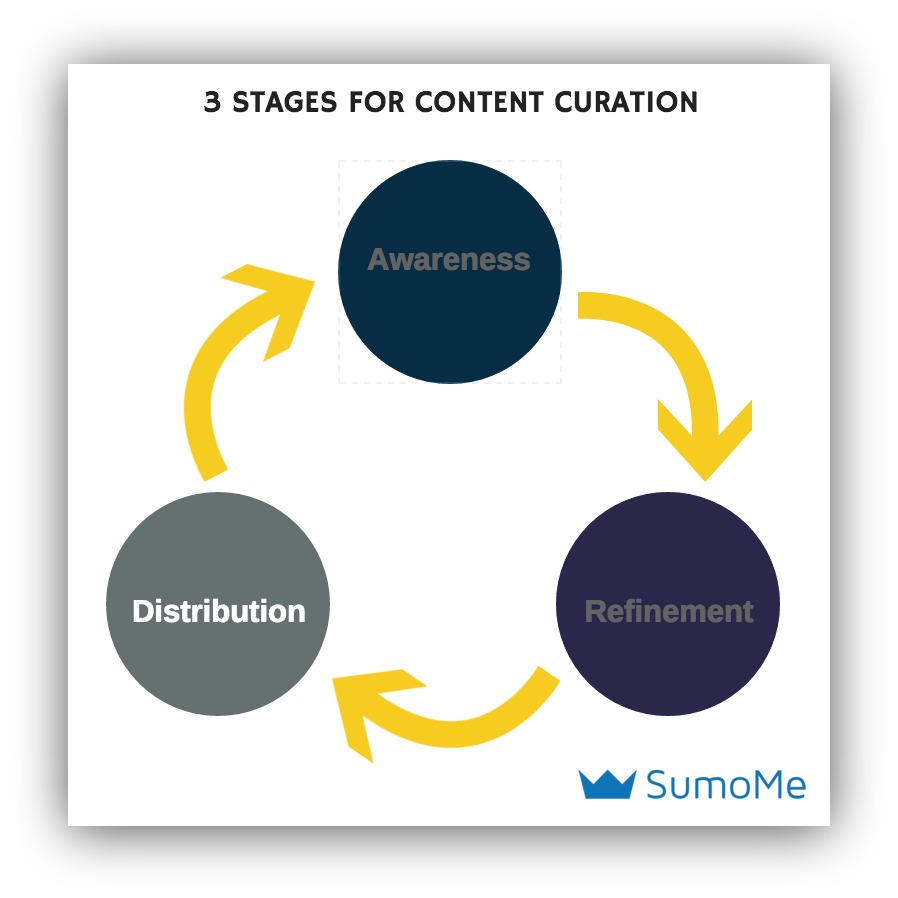
This is it, folks. This is where you turn all that hard work into subscribers and leads.

Get excited
It all comes together in this phase, and there are a multitude of ways to make your mark on the curation space. Each curator has their own way of doing things, and it all starts with how you present your curation.
How Will You Comment on Content?
This is ultimately how you set yourself apart from the competition. Anyone can put some links on a page and send it out. But you, my friend, are more than that.
You can inject personality into your commentary. You can take a “just the facts, ma’am” approach. You can send out multiple sources per day, or you can dedicate an entire post to one piece of content.
The choice is yours. And I’m here to help you figure out what choice you should make by showing what the best in the industry do.
1) A Little Commentary
This is a popular route for many content curators. The content you include in your curation will speak loud enough, so many curators tend to “say what it is and get out of the way.”
Hiten Shah subscribes to that theory. Here’s how a typical roundup looks from Hiten’s SaaS Weekly:

Excerpt of Saas Weekly
A couple things to note here:
- He Curates By Subtopic: Hiten included the same six topics in every newsletter: business, product, marketing, sales, growth and tip of the week. SaaS is a large topic, but by curating articles from these individual areas he can cater to a wide audience.
- He Posts Title and Sentence: Both link to the content, which makes it very accessible to the reader. His never uses more than a sentence to describe what the content is about.
- He Makes it Interesting: Read those sentences in the email. Do they seem appealing? You bet they do. They tell you what you’ll learn, which is what readers want the most.
- It’s Weekly: Hiten includes 10-12 articles per email. Since it’s weekly, you know it’s the BEST articles of the week. That implicit promise helps build a strong brand as a curator.
In a similar vein, Jason Martin sends out a weekly newsletter: Startup Growth Weekly. I’m including this example because it’s the same topic (Startup/SaaS), it’s also weekly and it’s structured by subtopics. But look how a curator’s choices can make it look and feel different:
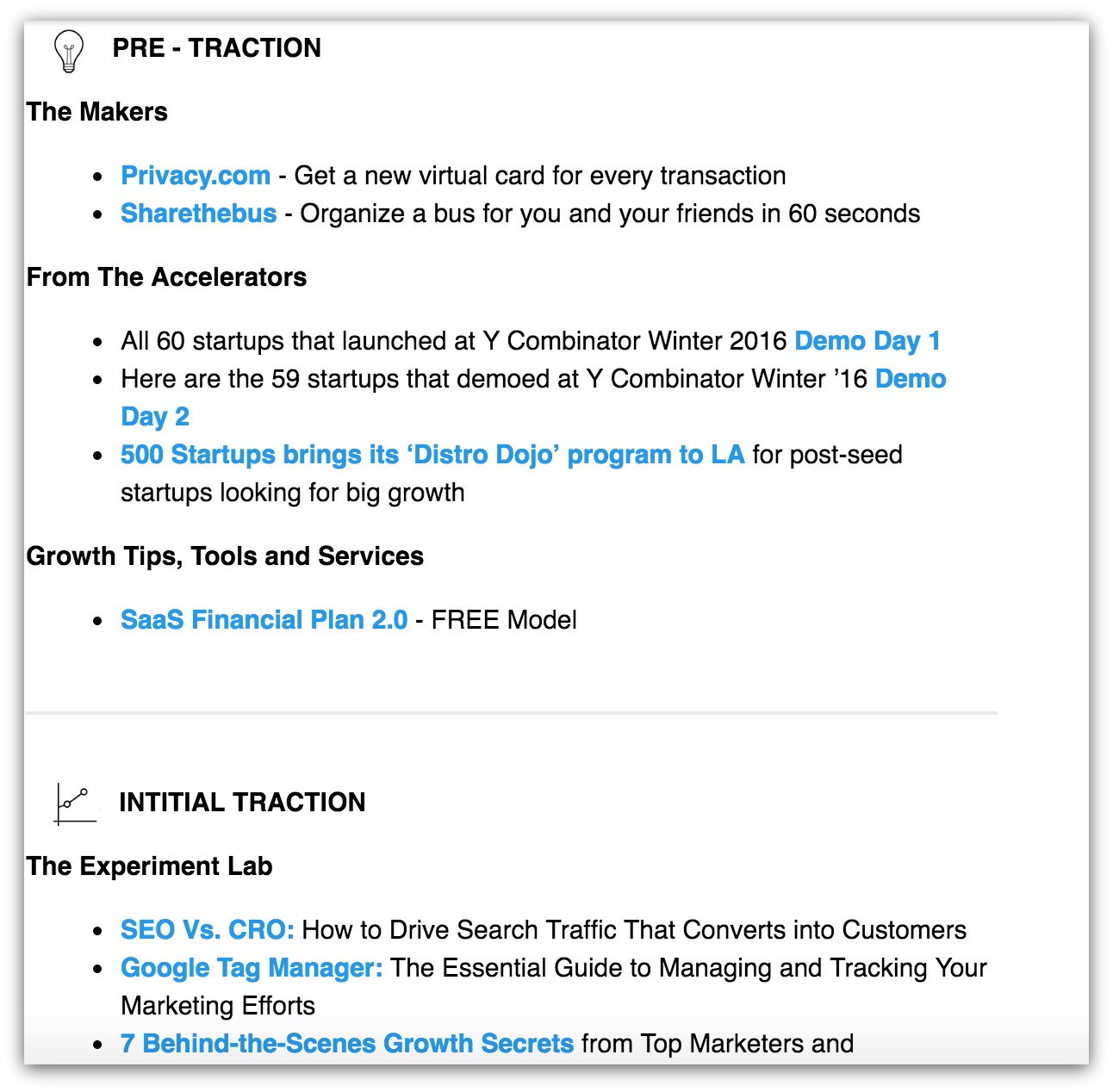
Let’s point out the differences that make his curation distinctly his:
- The Subtopics Are Unique: Instead of by department, Jason sorts by the phase a startup is in. His four topics are: Pre-Traction; Initial Traction; Initial Scale; and Scale.
- The Curation Commentary is Shorter: Each link is tailored with relevant tips, news and resources for each phase of a startup. It’s very much a “here it is, short and simple” approach.
The point is, there might be others that curate the same type of content as you. But if you can find your own unique way to present that content, it can tremendously raise your value.
These two keep things short and sweet with their content. They don’t try to sell you on any one piece. Instead they let the content choices speak for the curator.
But what if you want to add a little more of yourself to the curation process?
2) Moderate Commentary
Moderate in this sense can mean two things: either moderate in length or moderate in amount of personality you infuse.
Here’s a perfect example of those two in action from Jay Baer with his post on 33 Top Marketing Blogs:
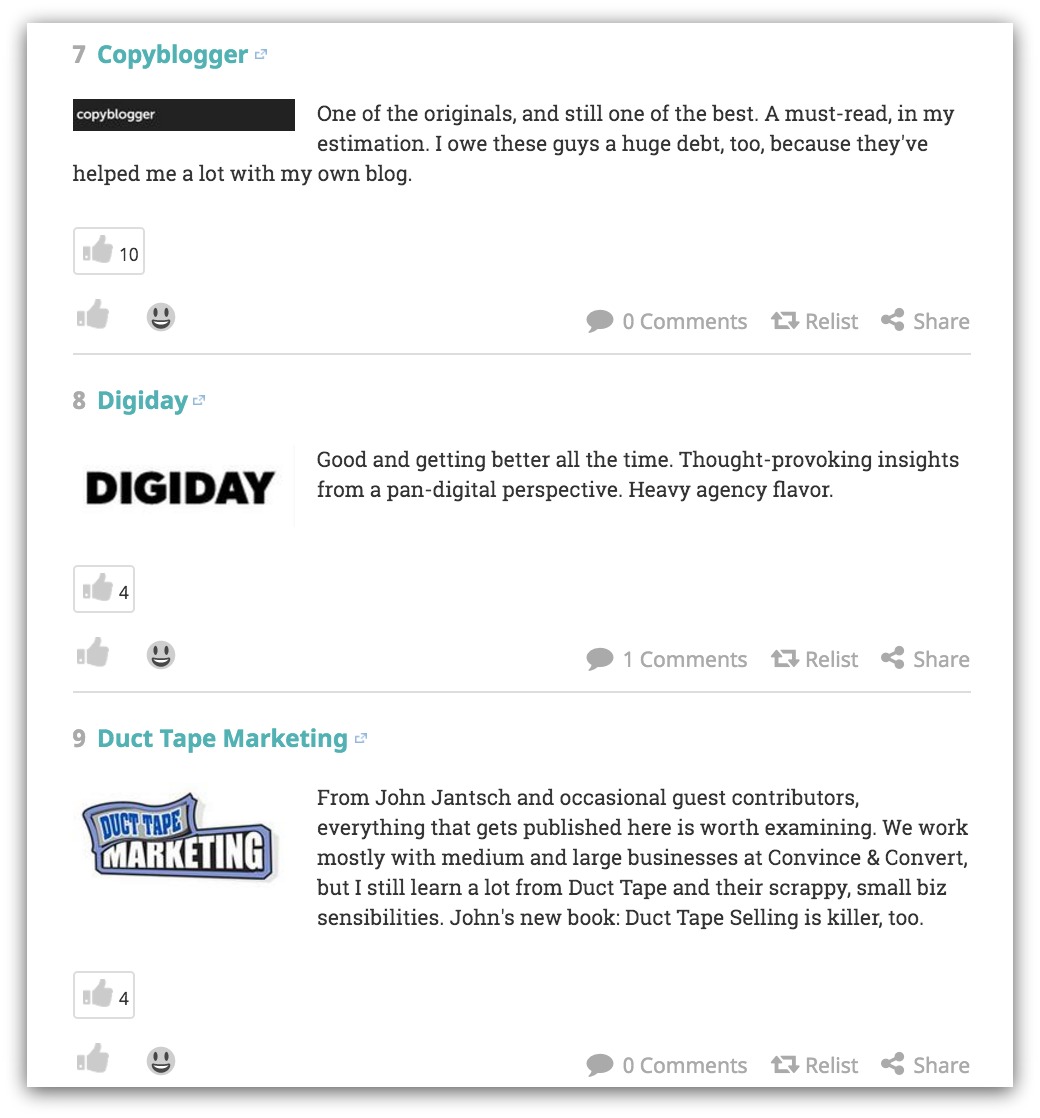
Look how much reflection and personality is in here. Phrases like “A must read, in my opinion,” and “…I still learn a lot from Duct Tape Marketing” give you a window into his real thought process behind the picks.
Plus, the length in commentary varies. Some commentary is a sentence, while others are five lines long. It’s a good mix of strong content with personable commentary.
You see this tactic on blogs quite a bit. If we go back to my dog example, you see it in posts like this:
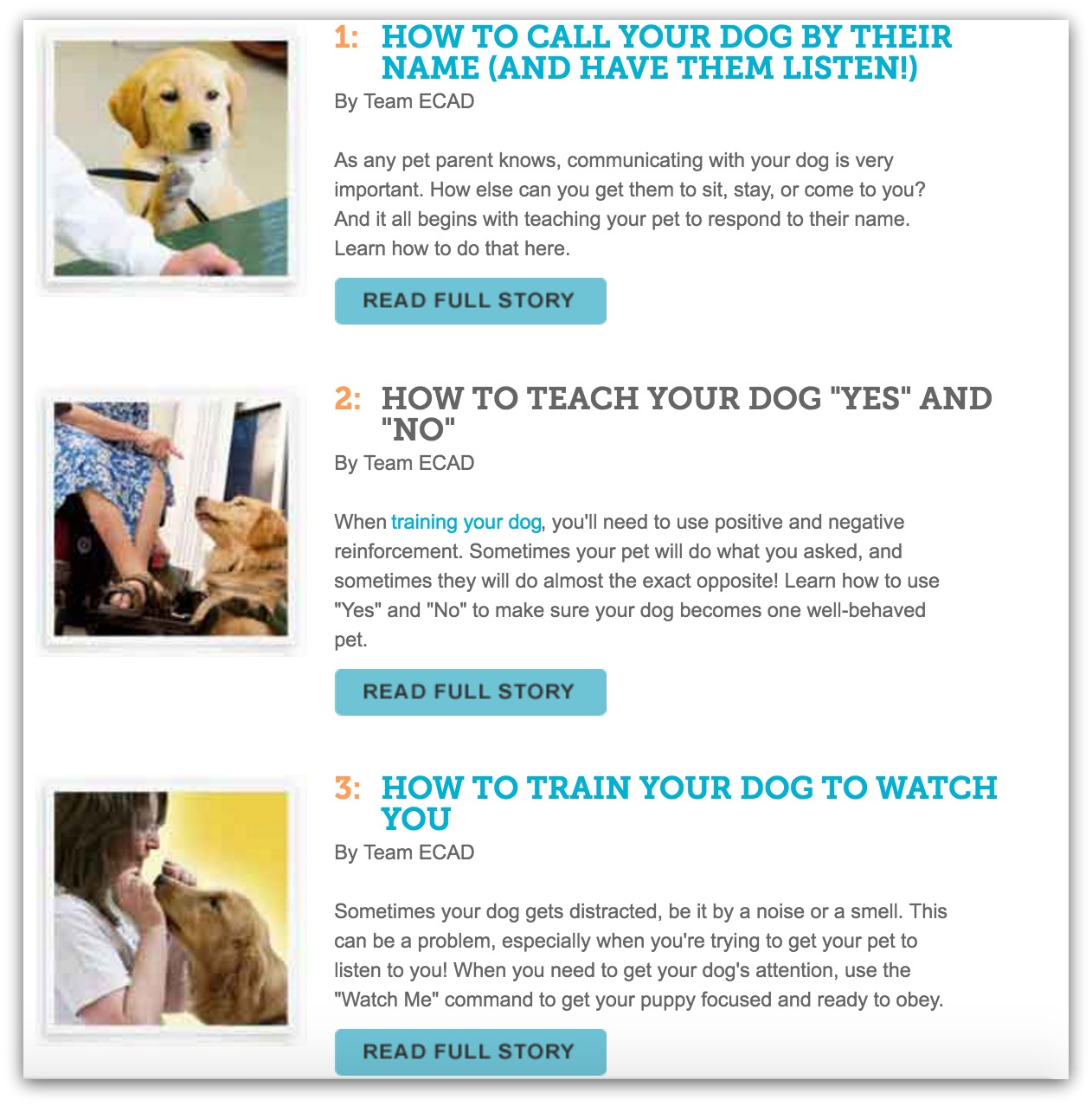
Excerpt from 20 Dog Commands You Need to Know
There’s a good amount of commentary to sell you on the content. They outline the problem, what you want and how they’ll help you achieve your goal.
This method is a great way to intertwine the strength of the content and your personality. But what happens when you want to really give an in-depth look at great content?
You go to the last option of commentary.
3) Big Ass Commentary
I think it was the great Disney Channel muse Johnny Tsunami that once said, “Go big or go home.”
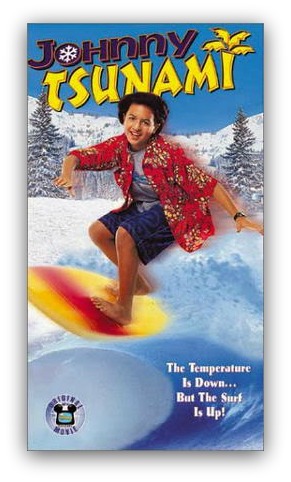
Never, ever forget this movie.
Some curators like to make their mark by releasing big pieces of commentary on one or few pieces of content.
You can focus on a few contributors like Kavi Guppta did on The Content Strategist:
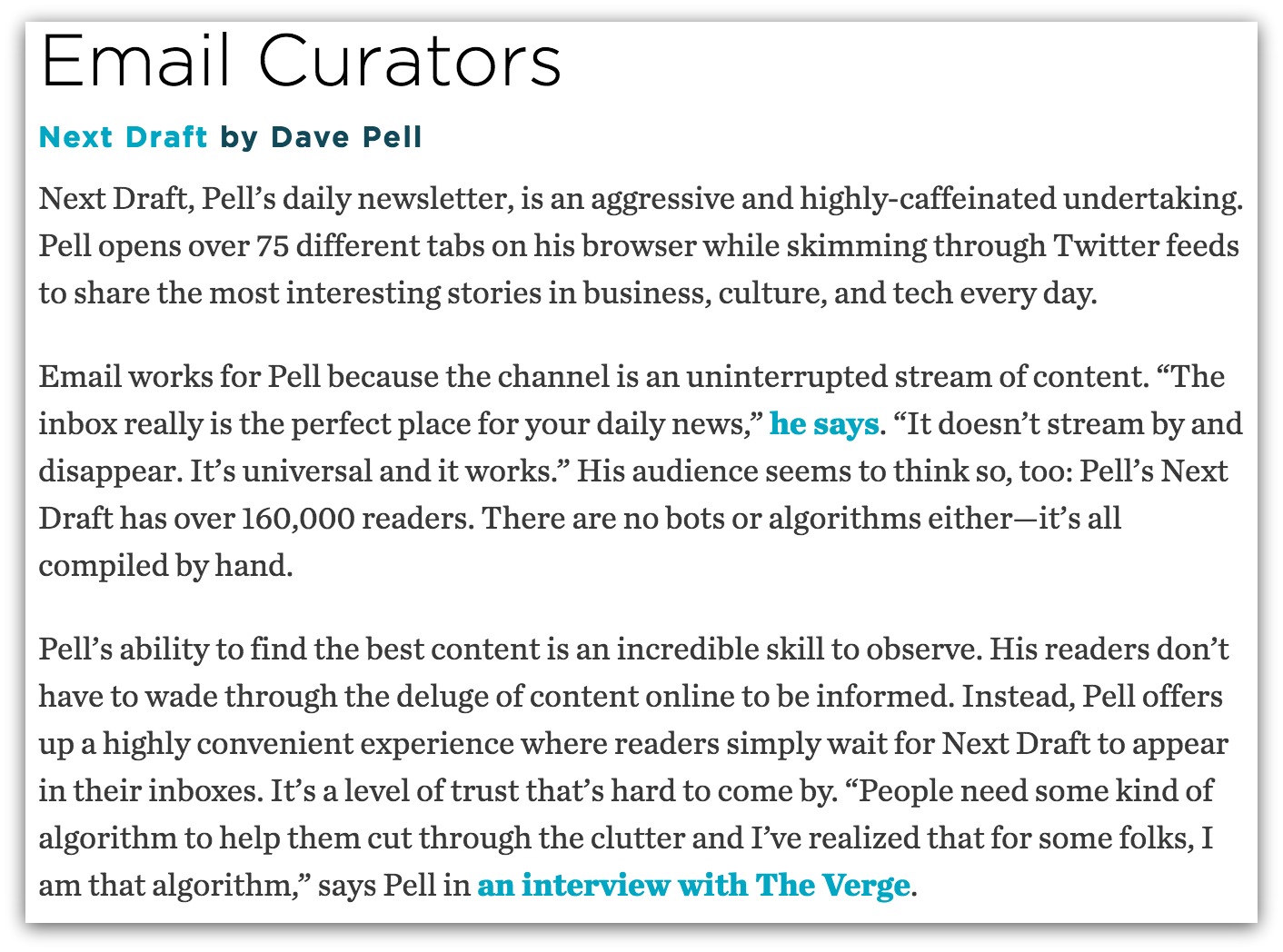
He picked out his five content curators on the internet and created a writeup that long for each curator. It really gives next-level, in-depth insight as to why Kavi thinks these five people are the best curators on the internet.
But if you’re looking for the biggest of big ass commentary in existence, we turn once again to the queen of content curation — Maria Popova:
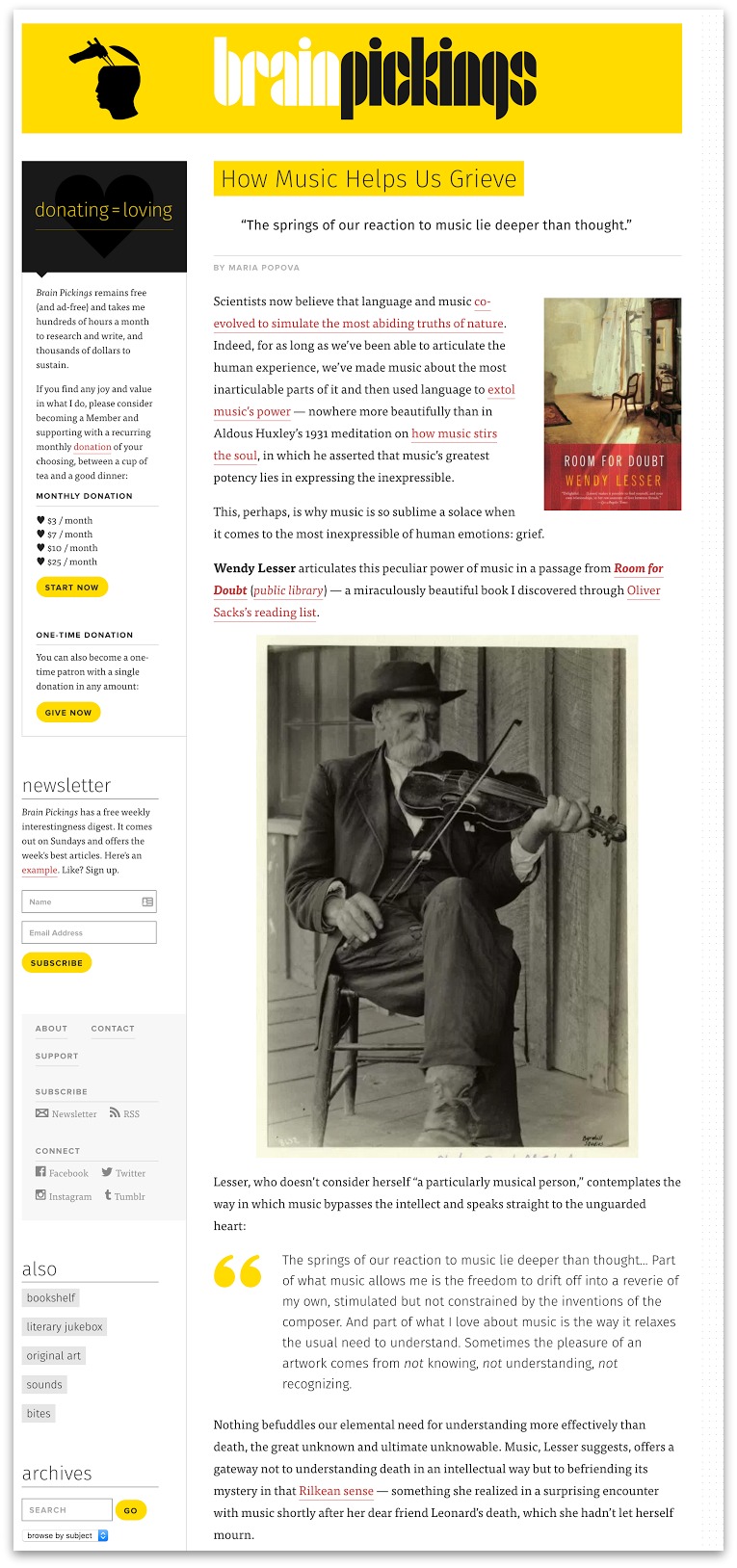
This is just an excerpt from a post where she talks about the book Room for Doubt. Maria routinely writes posts of 1,000 words at minimum on a single piece of content she liked.
That’s big. When you go this route with commentary, you’re taking the approach that your viewpoint on that piece of content is almost the end-all, be-all of commentary.
Something else to note from Maria: she does this daily. As a curator, you get to decide how often you publish your content. Some go daily, others weekly, some monthly.
You have to decide what kind of workload you can handle and publish without ever missing a deadline.
The length and type of commentary you choose is up to you, too. One is no better than the other — it just depends on what type of curator you want to be known as: short and to the point, or longer and in-depth.
Once you figure out your commentary style and how often you want to publish, it’s down to…well…you know…
Actually sending your work out into the world.
Where to Distribute Your Curation?
You’re a busy person. And this post has been all about using the minimum amount of tools and tactics to have maximum impact.
So when we talk about where to distribute your curation, we’ll look at the three most common outlets for this message: Twitter, email and blog posts.
1) Twitter
This one takes the least amount of time thanks to the amount of social share abilities on web pages. It makes it easy to share content you love with just one click (and for others to share your stuff, too).
I mean, just look to the left of these words. There’s a share bar right there. Convenient, no?
Your feed should be full of the content you’ve curated (and even some that barely missed the cut). Think about people like Sujan Patel when you’re doing this. This is his Twitter feed:
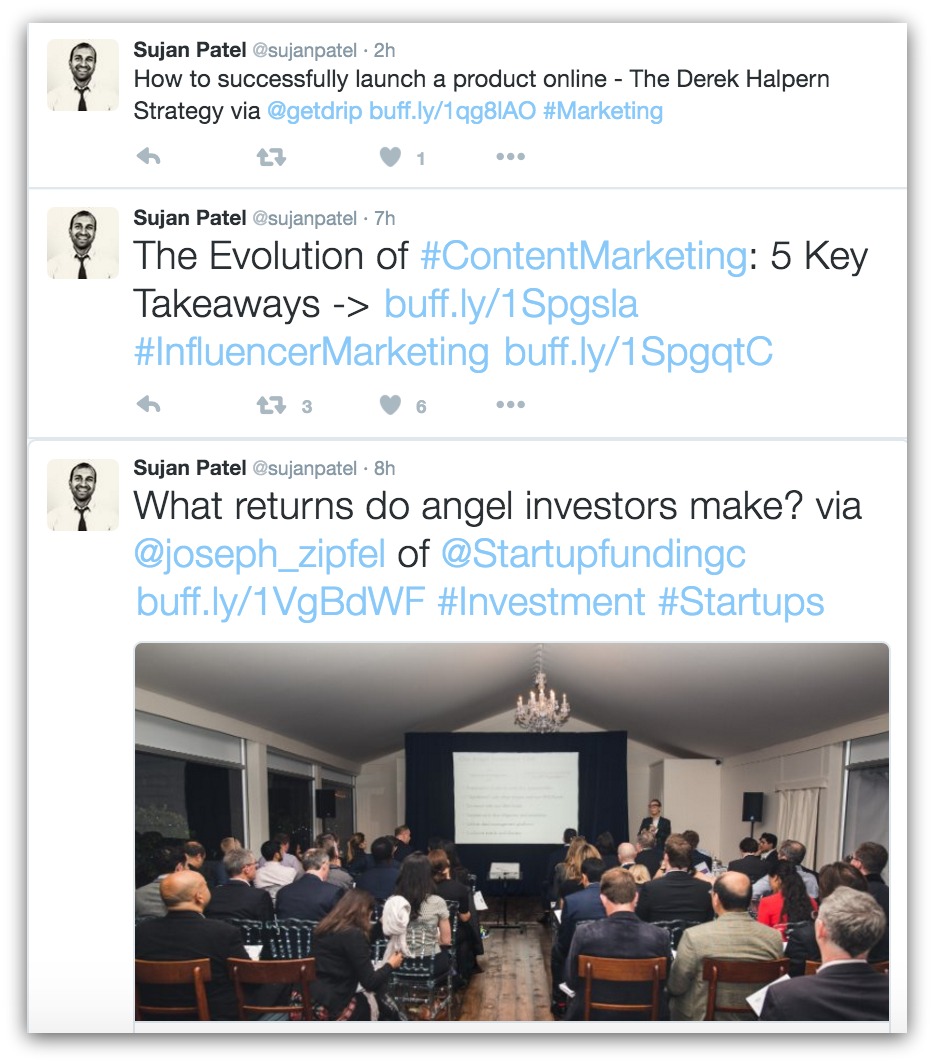
He’s all about growth hacking and startups, and you see it in his feed. He posts about 12 times a day with his favorite content.
Guess what? He’s got 26.8k followers, too. Being diligent in your sharing can help you get there. You can share that content out two ways:
1. Share Immediately: Whenever you see a post you like, you can share it immediately by clicking on a built-in share button included on almost every blog in existence.
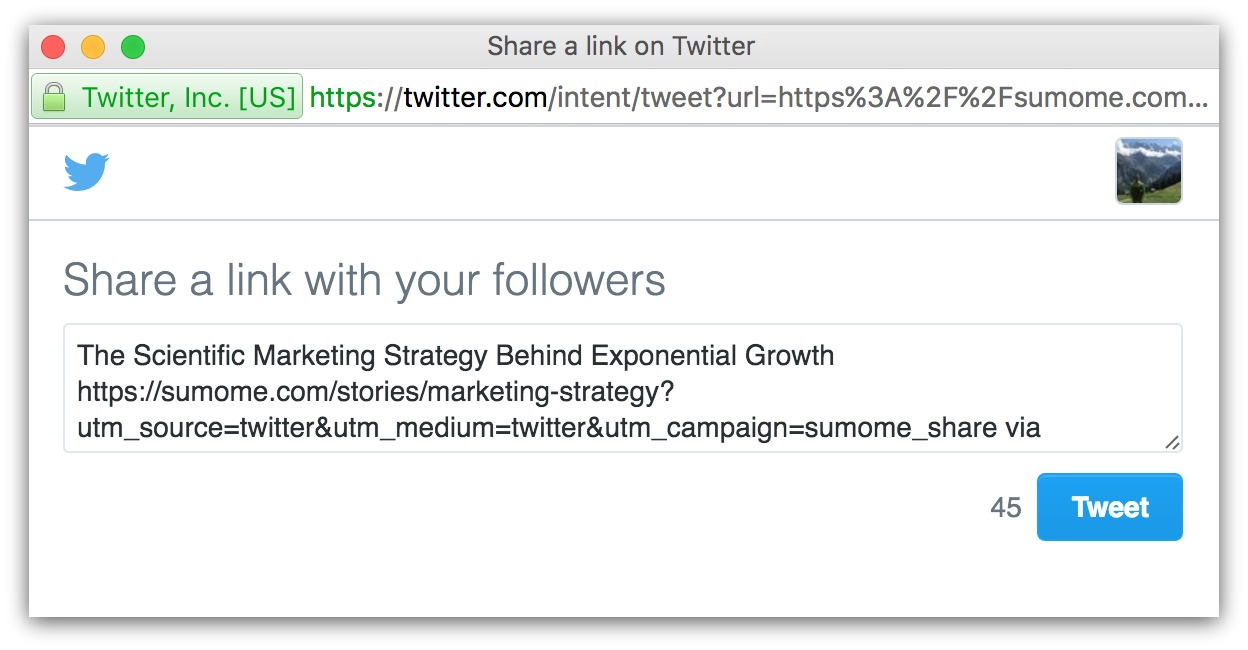
2. Schedule it Out: If you want to have consistent content throughout the day, you can use a tool like HootSuite to schedule out your posts. That way you’re almost always top-of-feed with constant content.

Think of Twitter as an extension to your brand. If you post enough about a certain topic, you’ll be seen as an expert.
That’s when the followers start to roll in. But this is just a small way to prove your badass curation powers. You can also use…
2) Email
Ah, email: one of the favorite distribution methods of curators.
We’ve already seen folks like Hiten Shah, Jason Martin and Dave Pell use it, but there are TONS of other marketers like Mari Smith, Growth Hackers, Duct Tape Marketing and more using it.
Why? Because 77% of people prefer getting emails over any other form of communication.
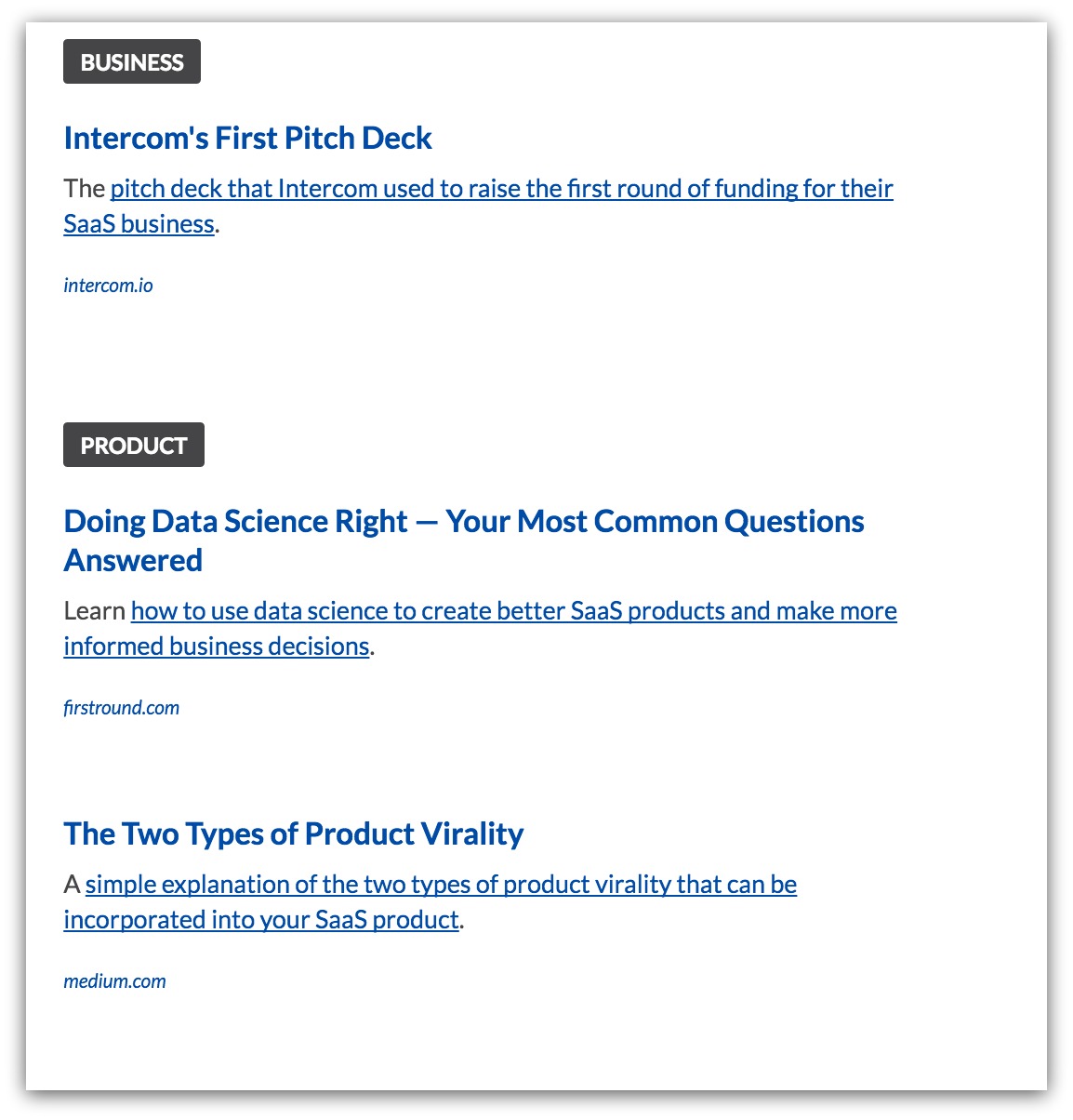
They love the emails.
We’ve already seen examples of curated emails in this post. But you can break down their layouts into two categories:
- Just Text: Hiten Shah does it. Jason Martin does it. Dave Pell does it. It’s just easier to do. People care about the content more than anything, so you can simply keep it to text in your email.
- All Fancy: If you’re looking for a more visual experience, you can include imagery and advanced layout techniques in your emails. Paper.li is an awesome tool that takes your curated content and turns it into a beautiful email.
Before you run with one or the other, try out some small tests to see what your audience likes better. Remember: they’re here for the content, so give that to them as easily as possible.
And that brings us to the last channel you should use to distribute your curated content.
3) Blog Post
Using blog posts to present and distribute your content is quite possibly the best way to build your brand for two reasons.
One, you get more content on your site. That’s just a given, really. It adds to your editorial calendar, which can bring in more readers.
But that’s not where the money is. The big payoff comes from your post ranking in search engines.
Oh yes. And rank they shall (if you play your cards right).
For example: a few days ago I was searching the Google for “best email subject lines.” I was scrolling through when I came upon this monster:

557?! You kidding me? I clicked on the post and guess what?
It was a curated post.
So it wasn’t 557 email subject line tips all individually spelled out on one page. It was a curation of the best email hacks on the web.
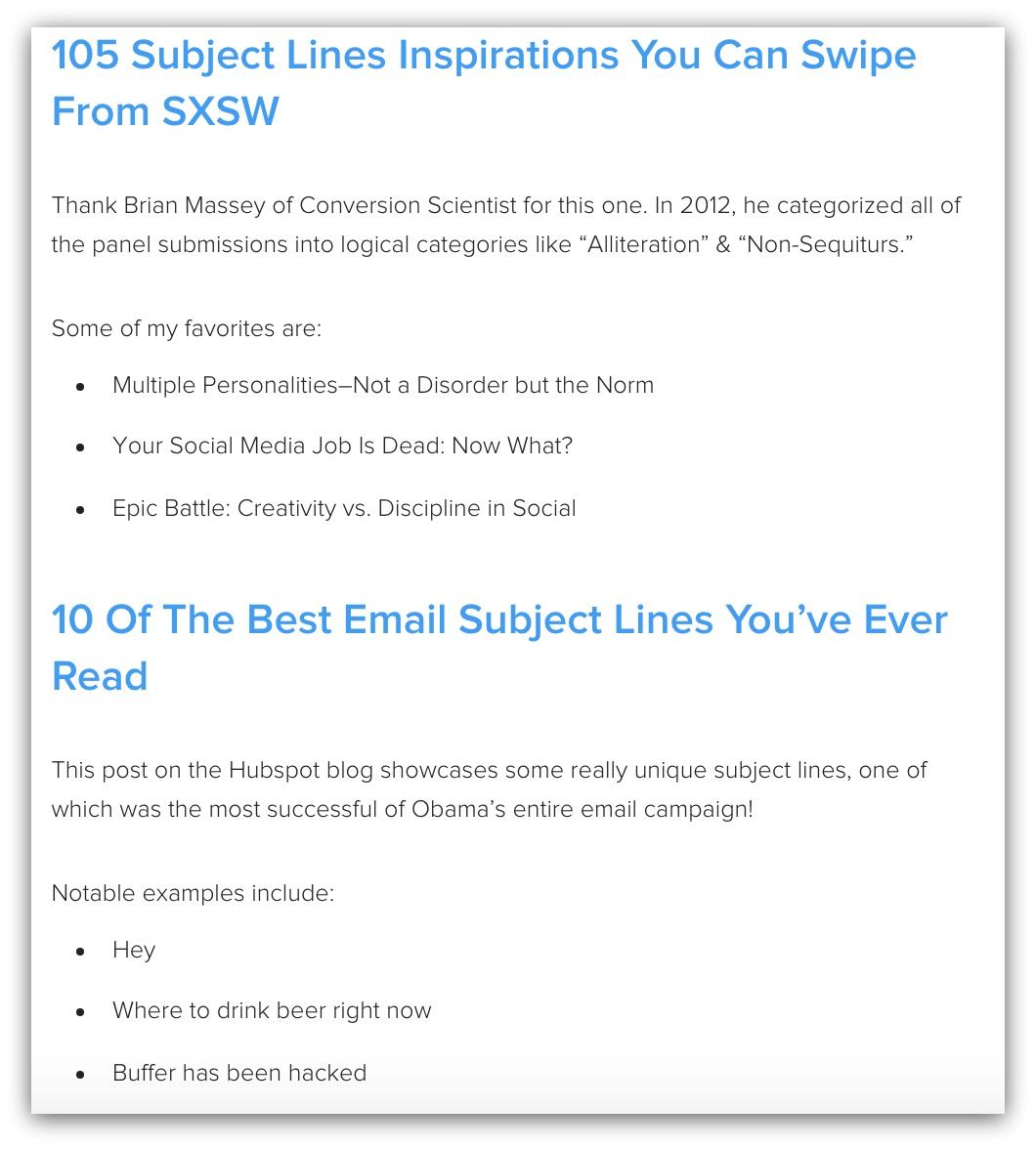
Etc. Etc…
Think about that for a second. Just by curating some content on one topic and publishing it as a blog post, they got their brand to the first page of Google.
So when you’ve published your favorite content to Twitter and sent out your daily (or weekly) roundup to your audience, take the next step and publish that stuff to your blog.
If you take all your best content on a certain topic and package it like they did on CrazyEgg, you too may catapult up the Google ranks.
So with that, let’s go back to our original content curation idea:

You’ve nailed the tools for content aggregation in the Awareness phase.
And you’ve developed expert-level taste in content through the Refinement phase.
Then you’ve published your curated content through Twitter, emails and blog posts in the Distribution phase.
But even after you’ve done all that, there’s one nagging question you’ve got to answer.
You’ve Published Your Curation…Now What?
This, above all, is the biggest question I get from new and veteran curators alike.
The content is great. The commentary is flawless. You’ve even sent out an email to a few people or published a post with your curation front-and-center.
So what now?
It’s time to build a following.
And by build a following, I mean focusing on building up an awesome email list to send your curated content to. OR, you can use your curated content to build a list and email them on any other messaging you’ve got.
And for that, we turn to the Google Keyword Plan…
Kidding. For this, we once more turn to the best content curator in the land: Maria Popova.
- The same person that spends 450 hours each month creating awesome content.
- The same person that sees 5 million people per month on her site.
- The same person whose site (Brain Pickings) was included in the Library of Congress permanent web archive in 2012.
Guess what? Maria Popova uses Sumo to build her email list.
Specifically, she uses List Builder:
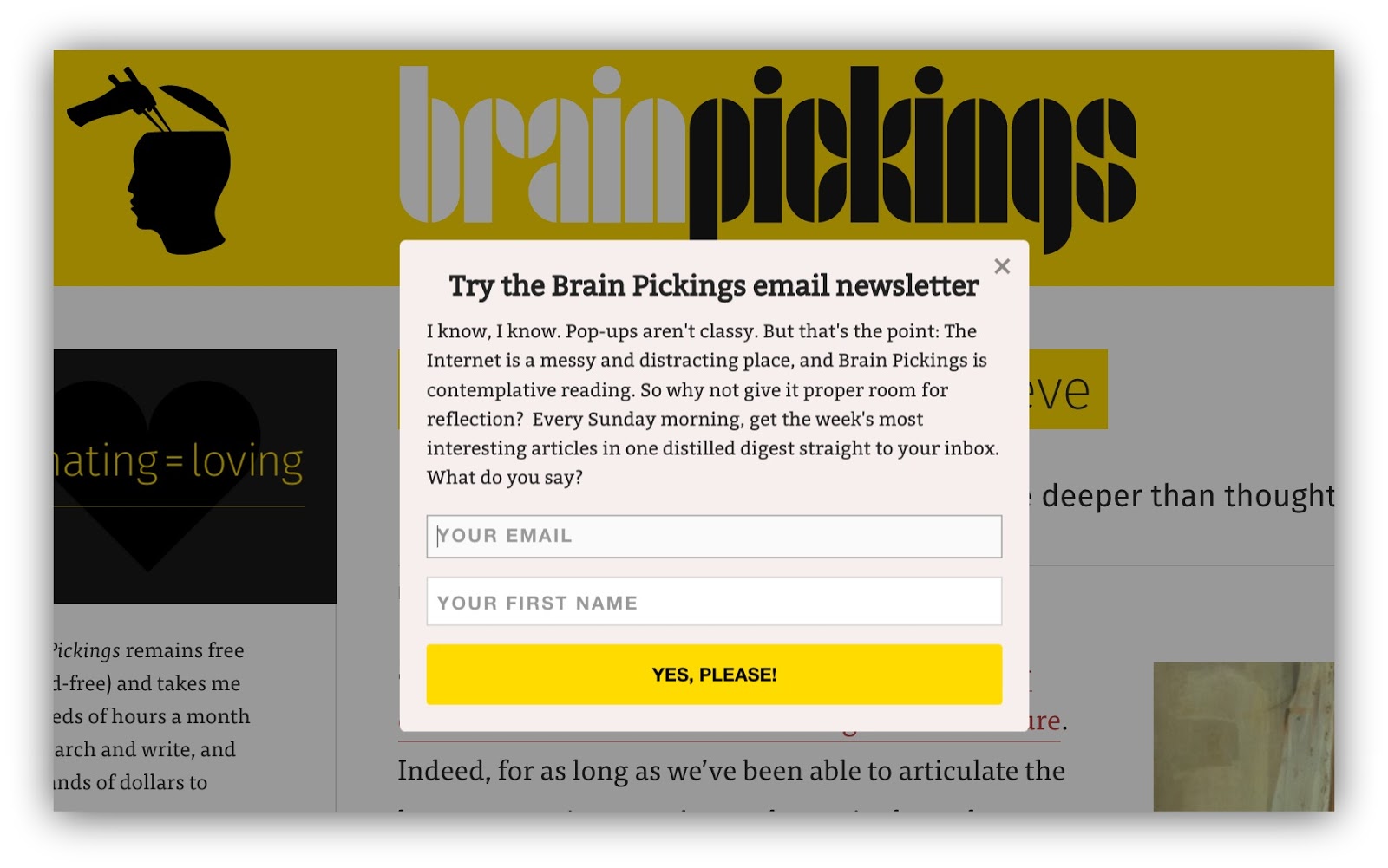
Proof!
It can easily increase subscribers by 20% per month, and Maria can attest to that.
Just by using List Builder, she added 62,834 new email addresses in just a few months.
Crazy, right? But if the best content curator of our time is using this tool to grow her email list, it must be doing something right.
This is the best way to take advantage of your curated content, and you can try it out and start building your list today in under ten minutes.










Add A Comment
VIEW THE COMMENTS